FreeWave Technologies 1293514195135 406.1-430MHz, 2 W, Licensed Radio System User Manual Exhibit D Users Manual per 2 1033 c3
FreeWave Technologies Inc. 406.1-430MHz, 2 W, Licensed Radio System Exhibit D Users Manual per 2 1033 c3
Exhibit D Users Manual per 2 1033 c3

LRS400S Data Transceiver Manual
LUM0025AA Rev A Version 1.0 i
FreeWave Technologies
LRS400S
Data Transceiver
Version 1.0
FreeWave Technologies, Inc.
1880 South Flatiron Court
Boulder, CO 80301
(303) 444-9200
(303) 786-9948 Fax
www.FreeWave.com

LRS400S Data Transceiver Users Manual
LUM0025AA Rev A Version 1.0 ii
LICENSED BAND WIRELESS DATA TRANSCEIVER USER MANUAL
Copyright © 1995-2010 by FreeWave Technologies, Inc. All rights reserved. Published 2010.
WARRANTY
FreeWave Technologies warrants your FreeWave® Wireless Data Transceiver against defects in
materials and manufacturing for a period of two years from the date of shipment. In the event of a
Product failure due to materials or workmanship, FreeWave will, at its option, repair or replace the
Product. The Product must be returned to FreeWave upon receiving a Return Material Authorization
(RMA) for evaluation of Warranty Coverage.
In no event will FreeWave Technologies Inc., its suppliers, and its licensors be liable for any damages
arising from the use of or inability to use this Product. This includes business interruption, loss of
business information, or other loss which may arise from the use of this Product. Please be advised that
OEM customer’s warranty periods may vary.
Warranty Policy may not apply:
1. If Product repair, adjustments or parts replacements is required due to accident, neglect, unusual
physical, electrical or electromagnetic stress.
2. If Product is used outside of FreeWave specifications.
3. If Product has been modified, repaired or altered by Customer unless FreeWave specifically
authorized such alterations in each instance in writing. This includes the addition of conformal
coating.
Special Rate Replacement Option
A special rate replacement option is offered to non-warranty returns or upgrades. The option to purchase
the replacement unit at this special rate is only valid for that RMA. The special replacement rate option
expires if not exercised within 30 days of final disposition of RMA.
RESTRICTED RIGHTS
Any product names mentioned in this manual may be trademarks, or registered trademarks of their
respective companies and are hereby acknowledged.
Information in this manual is subject to change without notice and is proprietary and confidential to
FreeWave Technologies, Inc.
This manual is for use by purchasers and other authorized users of the FreeWave® Wireless Data
Transceiver only.
No part of this manual may be reproduced or transmitted in any form or by any means, electronic or
mechanical, or for any purpose without the express written permission of FreeWave Technologies, Inc.
FreeWave’s Wireless Data Transceivers are designed and manufactured in the United States of America.
Printed in the United States of America.

LRS400S Data Transceiver Users Manual
LUM0025AA Rev A Version 1.0 iii
CAUTION: The LRS400S series transceiver have maximum transmitted output power of 2W. It is
recommended that the transmit antenna be kept at least 71 cm away from nearby persons to satisfy FCC
RF exposure requirements.

LRS400S Data Transceiver Users Manual
LUM0025AA Rev A Version 1.0 iv
Table of Contents
ABOUT FREEWAVE TRANSCEIVERS.................................................................................................................6
CHOOSING A LOCATION FOR THE TRANSCEIVERS....................................................................................6
CHOOSING POINT-TO-POINT OR POINT-TO-MULTIPOINT OPERATION ........................................................................7
QUICK START ON A POINT-TO-MULTIPOINT NETWORK ..........................................................................8
POINT-TO-MULTIPOINT OPERATION LEDS. ...............................................................................................................8
QUICK START ON A POINT-TO-POINT NETWORK........................................................................................9
POINT-TO-POINT OPERATION LEDS...........................................................................................................................9
SETTING UP A TRANSCEIVER ...........................................................................................................................10
OPERATION MODE....................................................................................................................................................10
BAUD RATE..............................................................................................................................................................12
CALL BOOK..............................................................................................................................................................15
RADIO TRANSMISSION CHARACTERISTICS ...............................................................................................................16
EDIT RADIO TRANSMISSION CHARACTERISTICS .......................................................................................................16
Setting Xmit and Rcv Frequencies.......................................................................................................................16
(1) and (2) Max Packet Size and Min Packet Size...............................................................................................17
(3) Xmit Rate........................................................................................................................................................18
(4) RF Data Rate .................................................................................................................................................18
(5)RF Xmit Power................................................................................................................................................18
(6) Slave Security.................................................................................................................................................19
(7) RTS to CTS.....................................................................................................................................................19
(8) Retry Time Out...............................................................................................................................................19
(9) Lowpower Mode.............................................................................................................................................20
(C) Remote LED ..................................................................................................................................................21
MULTIPOINT PARAMETERS ......................................................................................................................................22
EDIT MULTIPOINT PARAMETERS..............................................................................................................................22
(0) Repeaters........................................................................................................................................................22
(1) Master Packet Repeat ....................................................................................................................................22
(2) Max Slave Retry .............................................................................................................................................23
(3) Retry Odds .....................................................................................................................................................23
(4) DTR Connect..................................................................................................................................................23
(6) Network ID.....................................................................................................................................................23
(8) MultiMaster Sync...........................................................................................................................................23
(9) 1 PPS Enable/Delay.......................................................................................................................................23
(A) Slave/Repeater...............................................................................................................................................24
(B) Diagnostics....................................................................................................................................................24
(C) Subnet ID.......................................................................................................................................................24
(D) Radio ID........................................................................................................................................................25
(E) Local Access ..................................................................................................................................................25
(G) Radio Name...................................................................................................................................................25
RADIO INFORMATION ...............................................................................................................................................26
Number of Disconnects........................................................................................................................................26
Antenna Reflected Power.....................................................................................................................................26
Average Noise Level ............................................................................................................................................26
Average Signal Level...........................................................................................................................................27
Overall Rcv Rate (%)...........................................................................................................................................27
Radio Temperature..............................................................................................................................................27
FACTORY DEFAULT SETTINGS.........................................................................................................................28
OPERATIONAL RS-422 AND RS-485 INFORMATION .................................................................................................29
RS-422 and RS-485 Full Duplex Pin-Outs ..........................................................................................................30

LRS400S Data Transceiver Users Manual
LUM0025AA Rev A Version 1.0 v
RS-485 Half Duplex Pin-Outs..............................................................................................................................30
RS232 PIN ASSIGNMENTS ........................................................................................................................................30
RF BOARD PINOUT...................................................................................................................................................31
FREEWAVE TECHNICAL SUPPORT ............................................................................................................................31

LRS400S Data Transceiver Users Manual
LUM0025AA Rev A Version 1.0 6
About FreeWave Transceivers
FreeWave transceivers operate in virtually any environment where RS232 data communications occur. A
pair of transceivers function as a 9-pin null modem cable. If the FreeWave transceivers are to be used in
an application where a null modem cable is used, such as communication between two computers, then
the FreeWave transceivers can be connected directly. If FreeWave transceivers are to be used to replace
a straight-through RS232 cable, then a null modem cable must be placed between the transceiver and
the DTE instrument to which it is connected.
Choosing a Location for the Transceivers
Placement of the FreeWave transceiver is likely to have a significant impact on its performance. The key
to the overall robustness of the radio link is the height of the antenna. In general, FreeWave units with a
higher antenna placement will have a better communication link. In practice, the transceiver should be
placed away from computers, telephones, answering machines and other similar equipment. The RS232
cable included with the transceiver usually provides ample distance for placement away from other
equipment. To improve the data link, FreeWave Technologies offers directional antennas with cable
lengths ranging from 3 to 200 feet. When using an external antenna, placement of that antenna is critical
to a solid data link. Other antennas in close proximity are a potential source of interference; use the Radio
Statistics to help identify potential problems. The Show Radio Statistics page is found in option 4 in the
Main Menu. An adjustment as little as 2 feet in antenna placement can resolve some noise problems. In
extreme cases, band pass filter may reduce the out-of-band noise.

LRS400S Data Transceiver Users Manual
LUM0025AA Rev A Version 1.0 7
Choosing Point-to-Point or Point-to-MultiPoint Operation
A Point-to-Point network is limited to one Master and one Slave transceiver.
In a Point-to-MultiPoint network (also referred to as MultiPoint network) the transceiver, designated as a
Master, is able to simultaneously communicate with numerous Slaves. In its simplest form, a MultiPoint
network functions with the Master broadcasting its messages to all Slaves and the Slaves responding to
the Master when given data by the device connected to the data port.
It is important to note the differences between Point-to-Point and MultiPoint networks. In a Point-to-Point
network all packets are acknowledged, whether sent from the Master to the Slave or from the Slave to the
Master. In a MultiPoint network, outbound packets from the Master to Slaves are sent a set number of
times determined by the user. The receiving transceiver will accept the first packet received that passes
the 32 bit CRC. However, the packet is not acknowledged. On the return trip to the Master, all packets
sent by the Slave are acknowledged or retransmitted until they are acknowledged. Therefore, the return
link in a MultiPoint network is generally very robust.
Note: In licensed band operation it is suggested to set the repeated master packets at 0 due to
the spectrum being quiet. This will maximize throughput and leverage the advantages of licensed
band operation.
Traditionally, a MultiPoint network is used in applications where data is collected from many instruments
and reported back to one central site. As such, the architecture of such a network is different from Point-
to-Point applications. The number of radios in a MultiPoint network is influenced by the following
parameters:
1. Size of the blocks of data. The longer the data blocks, the smaller the network capacity.
2. Baud rate.
3. The amount of contention between Slaves. Polled Slaves vs. timed Slaves.
For example, if the network will be polling Slaves once a day to retrieve sparse data, several hundred
Slaves could be configured to a single Master. However, if each Slave will be transmitting data at greater
levels, then fewer Slaves should be linked to the Master. The overall network will be closer to capacity
with fewer Slaves.
For examples and additional information on data communication links, see the section Examples
of Data Communication Links later in this document.
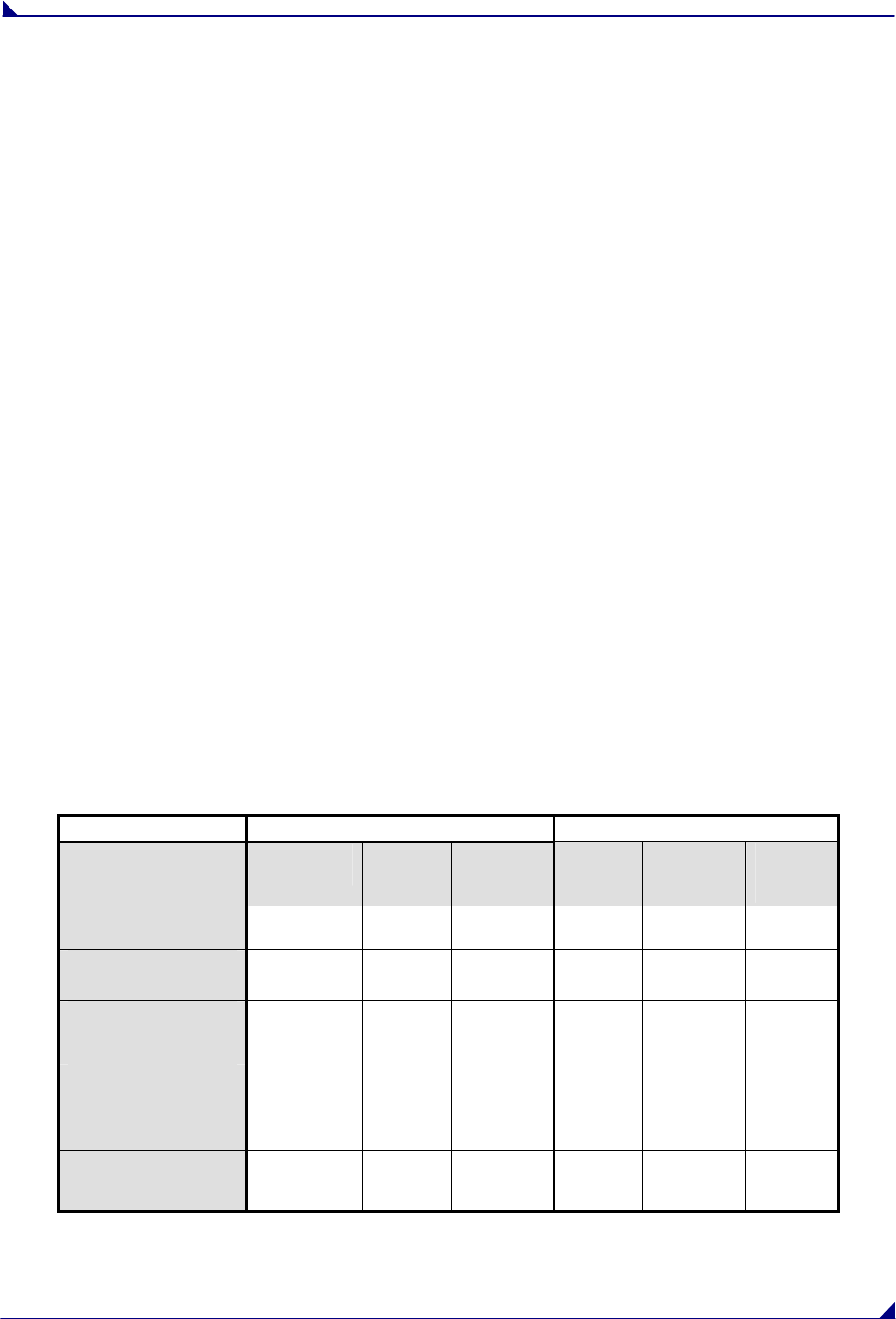
LRS400S Data Transceiver Users Manual
LUM0025AA Rev A Version 1.0 8
Quick Start on a Point-to-MultiPoint Network
The following is a quick start guide for setting up two transceivers in Point-to-MultiPoint mode. This mode allows for a
Master to communicate with several Slaves simultaneously.
1. Connect the transceiver to the serial port of a computer either through a serial cable or via the diagnostics
cable. Make sure to connect the radio to a power source (typically, 6 to 30 VDC).
2. Open up a HyperTerminal session.
• Use the following settings in connecting with HyperTerminal
• Connect to COMx (where 'x' is the number of the com port being connected to)
• Set data rate to - 19,200, data bits - 8, Parity- none, Stop bits – 1, Flow control – none.
3. Press the Setup button on the radio. If using the diagnostics cable, press Shift-U (capital U).
• The three lights on the board should all turn green, indicating Setup mode.
• The main menu will appear on the screen.
4. Press 0 to get into the Operation Mode menu.
• Press 2 to set the radio as a point to MultiPoint Master.
• OR, Press 3 to set the radio as a point to MultiPoint Slave.
• Press Esc to get back to Main menu.
5. Press 1 in the main menu to change the Baud Rate.
• The baud rate must be changed to match the baud rate of the device that the radio is to be attached to.
• Press Esc to get back to Main menu.
6. At the Main Menu, press 3.
• Set FreqKey, Max Packet Size, Min Packet Size, RF Data rate identical on all radios in the network.
Note: Changing these values may help to eliminate interference from other FreeWave networks.
• Press Esc to get back to Main menu.
7. At the Main Menu, press 5.
• Set the Network ID value to any value between 1 and 4095, except 255.
• Make sure this value is the same on every radio in the network.
Point-to-MultiPoint Operation LEDs.
Master Slave
Condition Carrier Detect
(CD) Transmit
(TX) Clear to
Send (CTS) Carrier
Detect
(CD)
Transmit
(TX) Clear to
Send
(CTS)
Powered, not linked Solid red
bright Solid red
dim Off Solid red
bright Off Blinking
red
Slave linked to Master,
no data Solid red
bright Solid red
dim Off Solid
green Off * Solid red
bright
Slave linked to Master,
Master sending data to
Slave
Solid red
bright Solid red
dim Off Solid
green Off * Solid red
bright
Slave linked to Master,
Slave sending data to
Master
Solid green
RCV data
or Solid red
bright
Solid red
dim Intermittent
flash
redÑoÒ
Solid
green Intermittent
flash
redÑoÒ
* Solid red
bright
Master with diagnostics
program running Solid red
bright Solid red
dim Intermittent
flash
redÑoÒ
Solid
green Intermittent
flash
redÑoÒ
* Solid red
bright
* Clear to Send LED will be solid red with a solid link, as the link weakens the Clear to Send LED light on the Slave
will begin to flash\.

LRS400S Data Transceiver Users Manual
LUM0025AA Rev A Version 1.0 9
Quick Start on a Point-to-Point Network
When purchased as a pair, the FreeWave® Wireless Data Transceivers are shipped from the factory pre-
configured to operate in Point-to-Point applications. To establish communications between a pair of
FreeWave Wireless Data Transceivers just received from the factory:
1. Connect antennas to the transceivers. Freewave Technologies recommends that the antenna
port be loaded at all times to prevent damage to the LRS400S radios. Noise potential may be
reduced on the bench by lowering the Xmit power.
2. Connect the transceiver to the instrument with the RS232 cable and also attach power. The
cable supplied with enclosed transceivers (except Waterproof) is a 9-pin male serial; professional
board level transceivers will need a separate programming cable (sold separately).
3. Set the Modem mode in each transceiver. One should be set as a Point-to-Point Master (Mode
0) and the other set as a Point-to-Point Slave (Mode 1).
4. Set the baud rate on each transceiver to match the baud rate of the instrument to which it is
attached. Please note, when setting the transceiver's baud rate, its RS232 data rate is set. The
baud rate does not have to be on the same setting for the two transceivers.
5. Edit the Call Book. Enter the Slave serial number in the Master’s Call Book. Enter the Master’s
Serial number in the Slave’s Call Book, or disable Slave Security (in the Slave).
6. Shortly after both transceivers are plugged in, they should establish a communications link with
each other and the connection is complete. Using the table below, verify that the radios are
operating as expected.
Point-to-Point Operation LEDs
Master Slave
Condition Carrier
Detect
(CD)
Transmit
(TX) Clear to
Send (CTS) Carrier
Detect (CD) Transmit
(TX) Clear to
Send (CTS)
Powered, no link Solid red
bright Solid red
bright Solid red
bright Solid red
bright Off Blinking red
\
Linked, sending
sparse data Solid
green Intermittent
flash
redÑoÒ
Intermittent
flash
redÑoÒ
Solid
green Intermittent
flash
redÑoÒ
Intermittent
flash
redÑoÒ
Master calling
Slave Solid red
bright Solid red
dim Solid red
bright Solid red
bright Off Blinking red
\
Mode 6 - waiting
for ATD command Solid red
bright Off Blinking
red\ Solid red
bright Off Blinking red
\
Setup Mode Solid
green Solid
green Solid green Solid
green Solid
green Solid
green
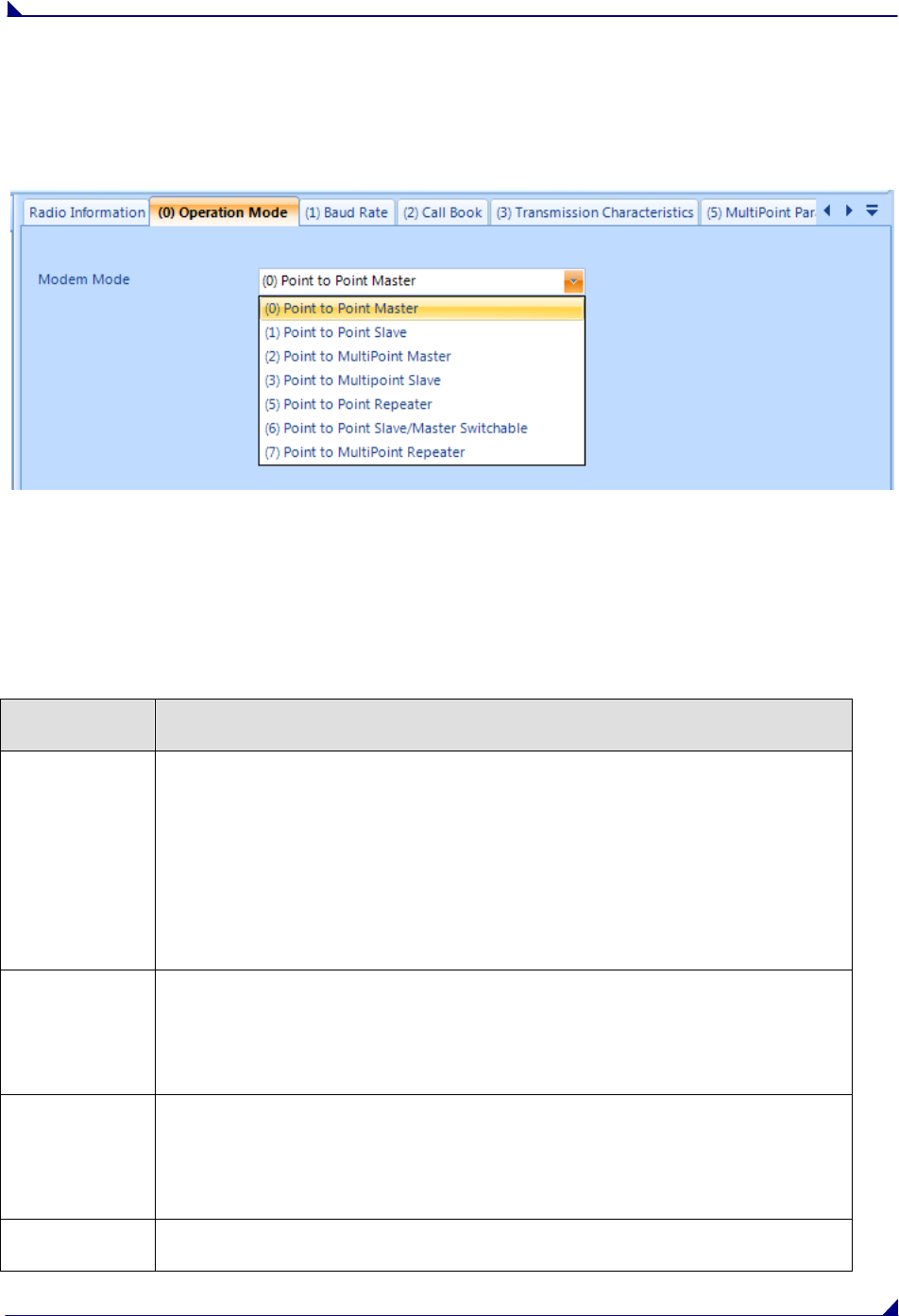
LRS400S Data Transceiver Users Manual
LUM0025AA Rev A Version 1.0 10
Setting up a Transceiver
Operation Mode
The Operation Mode option designates the method FreeWave transceivers use to communicate with
each other. FreeWave transceivers operate in a Master to Slave configuration. Before the transceivers
can operate together, they must be set up to properly communicate.
In a Point-to-Point configuration, Master or Slave Mode may be used on either end of the communication
link without performance degradation. When setting up the transceiver, remember that a number of
parameters are controlled by the settings in the Master. Therefore, deploying the Master on the
communications end where it will be easier to access is advised, but not necessary.
Operation
Mode Description
Point-to-Point
Master (0) This mode designates the transceiver as the Master in Point-to-Point mode. The
Master may call any or all Slaves designated in its Call Book.
In Point-to-Point mode the Master determines the setting used for most of the
radio transmission characteristics, regardless of the settings in the Slave. The
settings not determined by the Master are: RF Xmit Power, Slave Security, Retry
Time Out, and the Hop Table settings.
A quick method of identifying a Master is to power the transceiver. Prior to
establishing a communication link with a Slave, all three of the Master’s LEDs
will be solid red.
Point-to-Point
Slave (1) This mode designates the transceiver as a Slave in Point-to-Point mode. The
Slave communicates with any Master in its Call Book.
When functioning as a Slave, the Entry to Call feature in the transceiver’s Call
Book is not operational. The Call Book may be bypassed in the Slave by setting
Slave Security to 1. See the Slave Security section later in this manual.
Point–to-
MultiPoint
Master (2)
This mode designates the transceiver as a Master in MultiPoint mode. This
mode allows one Master transceiver to simultaneously be in communication with
numerous Slaves.
A Point-to-MultiPoint Master communicates only with other transceivers
designated as Point-to-MultiPoint Slaves.
Point-to-
MultiPoint This mode designates the transceiver as a Slave in MultiPoint mode. This mode
allows the Slave to communicate with a MultiPoint Master. The Slave may
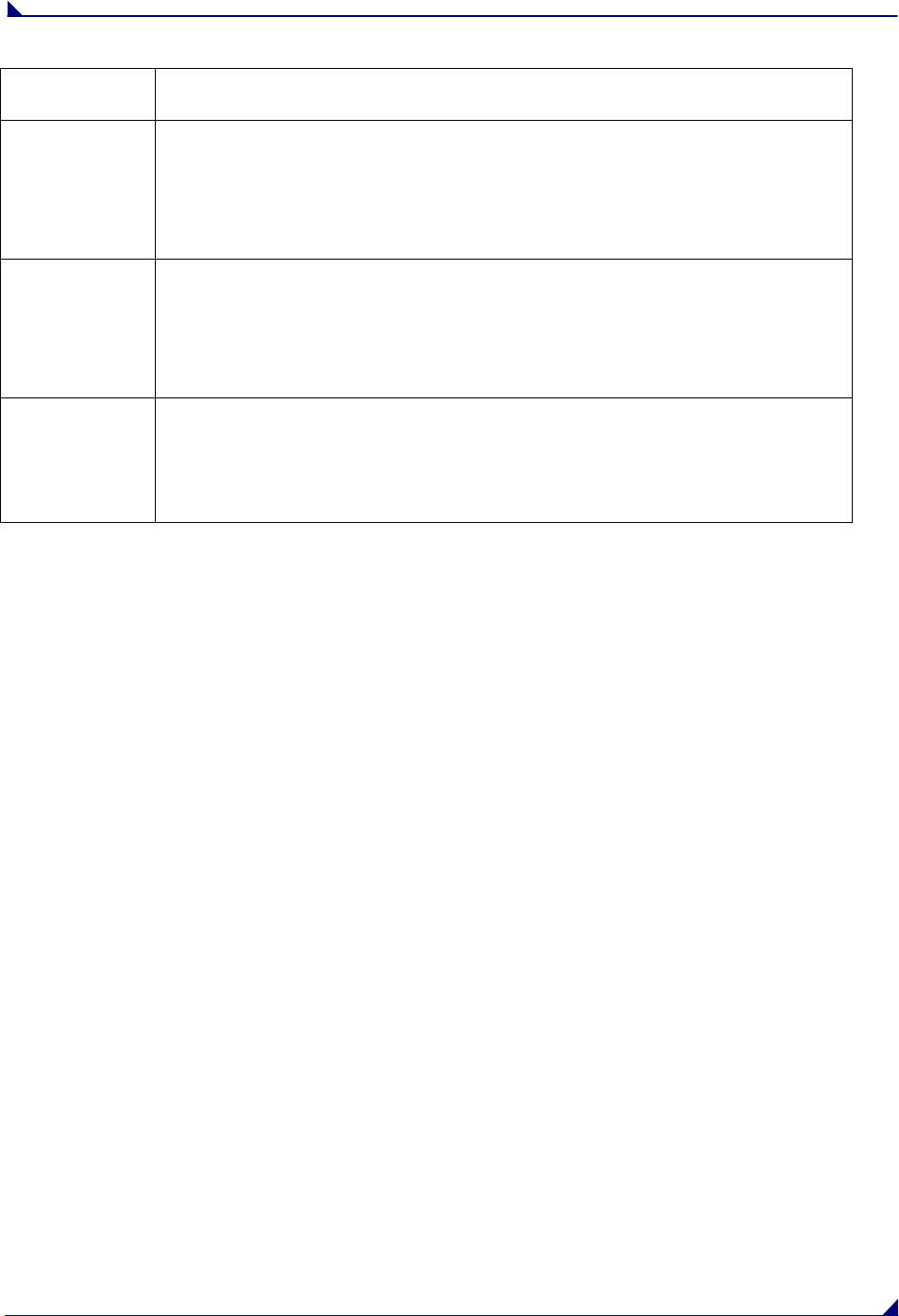
LRS400S Data Transceiver Users Manual
LUM0025AA Rev A Version 1.0 11
Slave (3) communicate with its Master.
Point-to-Point
Repeater (5) FreeWave allows the use of one repeater in a Point-to-Point communications
link, significantly extending the operating range. When designated as a
Repeater, a transceiver behaves as a pass-through link. All settings for the call
book, baud rates and radio transmission characteristics are disabled. A Repeater
will connect with any Master that calls it. The Repeater must be set up properly
in the Master's call book.
Point-to-Point
Slave/Master
Switchable (6)
Mode 6 allows the transceiver to be controlled entirely through software
commands. A number of key parameters in FreeWave's user interface may be
changed either directly with a program such as Windows Terminal or through the
use of script files. Additionally, when the Point-to-Point Slave/Master Switchable
option is selected and the transceiver is not calling a Slave, it will function as a
Slave and accept any appropriate calls from other transceivers.
Point-to-
MultiPoint
Repeater (7)
This option allows the transceiver to operate as a Repeater in a MultiPoint
network. See the MultiPoint parameters section for details on enabling
MultiPoint Slave/Repeater mode.
Note: The use of repeaters in Point to Multipoint Networks is restricted to one
repeater per network.
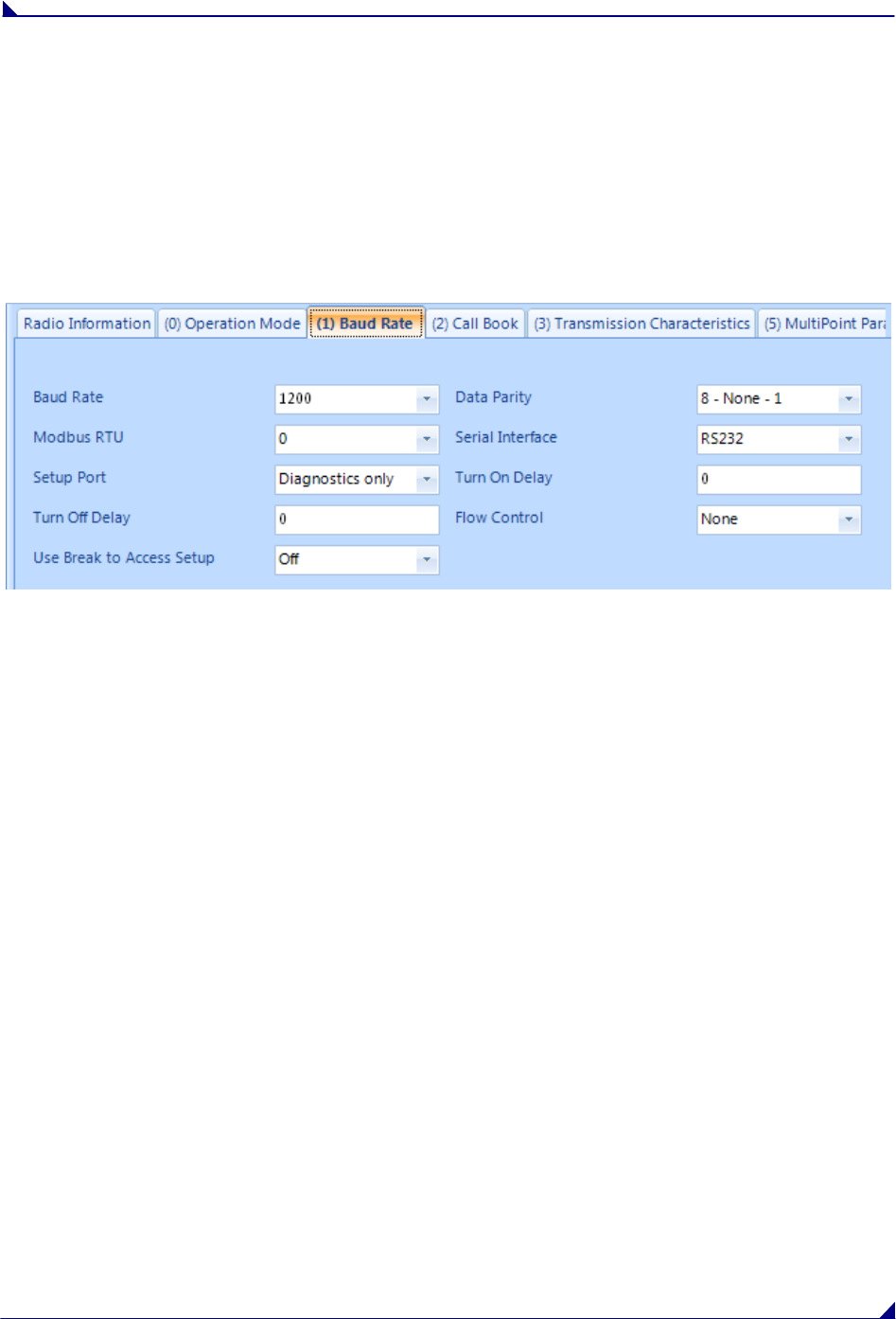
LRS400S Data Transceiver Users Manual
LUM0025AA Rev A Version 1.0 12
Baud Rate
This setting is the communication rate between the transceiver and the instrument to which it is
connected. It is important to note that this is independent of the baud rate for the other transceiver(s) in
the network. For example, a pair of transceivers may be used in an application to send data from remote
process instrumentation to an engineer's computer. In this application, the baud rate for the transceiver
on the instrumentation might be set to 9600, and the transceiver on the engineer’s computer might be set
to 57,600.
Set Baud Rate
1. Select the appropriate baud rate to match the attached device.

LRS400S Data Transceiver Users Manual
LUM0025AA Rev A Version 1.0 13
Baud Rate Description
Actual Baud Rate
(selections 0-9) The actual baud rate for the transceiver’s data port.
It is desirable to set the baud rate to the highest level supported by the device to
which it is connected. In certain circumstances, however, this may actually result
in slower data communications.
Data, Parity There are six data word length and parity configurations available to be used with
FreeWave transceivers. The default setting is 0 (8, N, 1) and is the most commonly
used serial communications protocol. Select the appropriate option to
communicate with the end device.
Data Bits Parity Stop Bits
8 None 1
7 Even 1
7 Odd 1
8 None 2
8 Even 1
8 Odd 1
Modbus RTU Support for Modbus RTU protocol is available. The default setting for Modbus
RTU is 0 (Not Enabled).
To enable Modbus capability, set Modbus RTU to 1.
Note: When using the transceiver in Modbus RTU mode, the Master Packet
Repeat must be set the same in all radios whether the network is in Point-to-Point o
r
MultiPoint mode. The Modbus RTU mode must be selected when transceivers are
configured in RS485 or RS422 mode.
Serial Interface In products for which the protocol of the data port is software selectable, use this
menu to set the protocol of the data port. In the TTL RF board product this setting
must be "0".
Protocol Additional Information
RS232 Also used for TTL transceivers.
RS422 Modbus RTU mode must be enabled. See above.
RS485 Modbus RTU mode must be enabled. See above.
DOT Special for the Department of Transportation.
Note: When DOT mode is enabled, the TimeDelay settings operate the same as
in the RS485/422 mode.
Note: RS4xx mode must have Modbus RTU enabled, and TurnoffDelay set to at
least 4.
Setup Port Note: DO NOT change this setting unless the correct programming cable is
available for the new setting.
This setting determines which port, Main or Diagnostics, is used to enter the Setup
Main Menu.
Port Additional Information
Main Only The terminal is connected to the Main Data Port.
Diagnostics Only The terminal is connected to the Diagnostic Port.

LRS400S Data Transceiver Users Manual
LUM0025AA Rev A Version 1.0 14
Both Ports The terminal may be connected to either port.
Setup mode is invoked by sending a "U" (capital) to the Diagnostics port or by
pressing/toggling the Set-up button/switch, if available. OEM boards may also
enter Setup when Pin 2 is grounded.
The Main Data Port is the RS232 port. The OEM modules use a 2-row, 2 mm
female connector. The diagnostic cable for this port (ASC2009DC) is available from
FreeWave.
TurnOn/OffDelay TurnOnDelay- Sets the delay between when the line drivers are turned on and
when the data leaves the data port. This setting can be adjusted for a 1-9 mS
delay.
TurnOffDelay- This setting specifies the time after the end of transmission of a
character to the RS485 bus that the transceiver stops driving the bus and releases
the bus to other devices. The units are ¼ of a character with a range of 0-9. An
entry of 4 means a delay equivalent to the duration of a full character. Default is
zero delay.
For data rates of 1200 bits/S or slower, avoid setting the TurnoffDelay parameter
higher than 4. At those rates the functionality of the microprocessor changes so
that a TurnoffDelay of 5 will have the same effect as if set to 1, and a setting of 6
will have the same effect as 2, and so on.
Note: TurnOffDelay must be set to a value of at least 4 for RS4xx operation.
FlowControl This menu specifies the hardware flow control for the Data port. The options for 0-3
are described below.
Port Additional Information
None Default - Uses software control (XON XOFF)
RTS
DTR
DOT
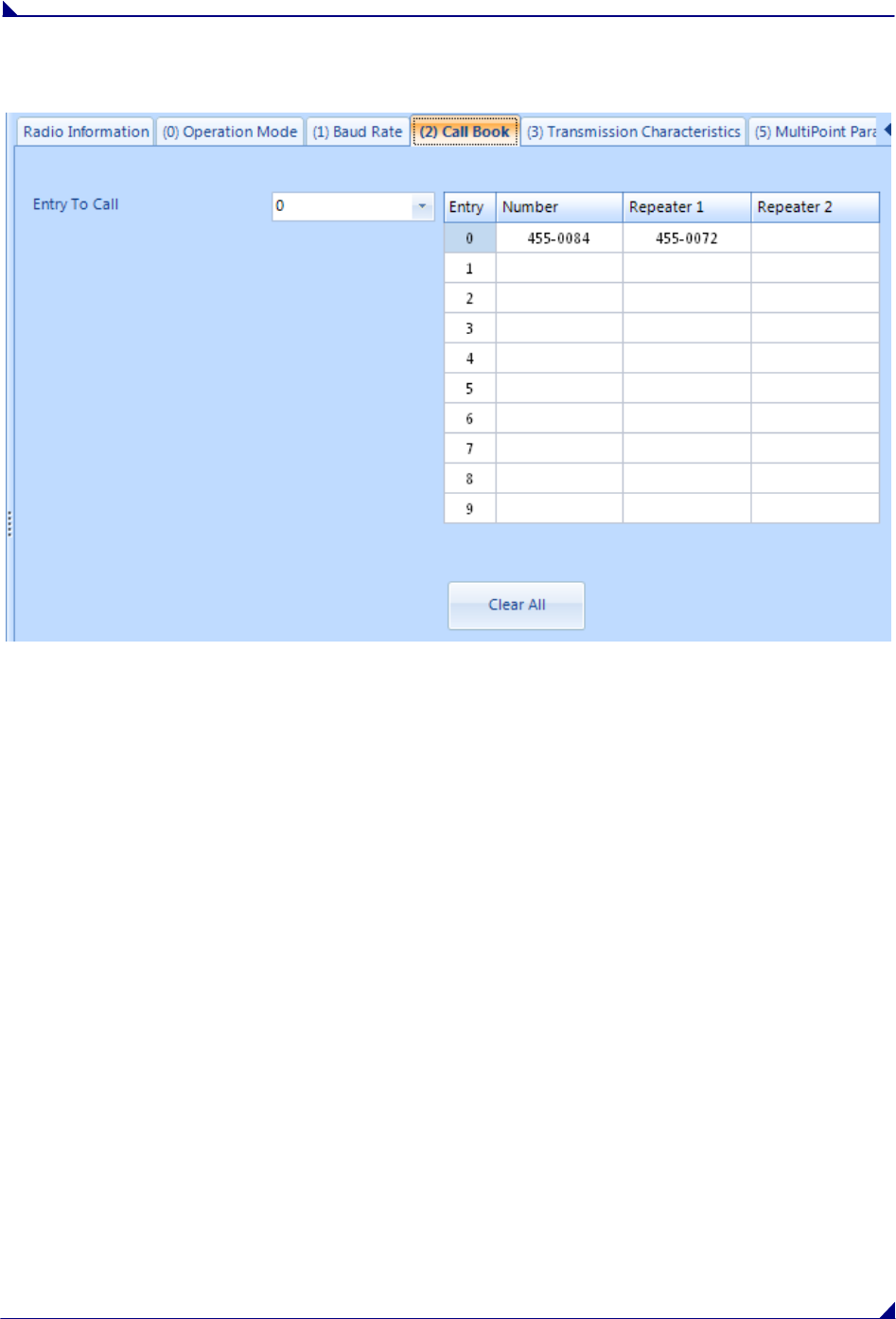
LRS400S Data Transceiver Users Manual
LUM0025AA Rev A Version 1.0 15
Call Book
The Call Book is required to be used in Point-to-Point networks. The instructions provided in this section
are for Point-to-Point mode only.
Using the Call Book offers both security and flexibility in determining how FreeWave transceivers
communicate with each other.
Three settings must be made for two FreeWave transceivers to communicate in Point-to-Point mode:
1. The Master’s serial number must be listed in the Slave's Call Book or Slave Security is turned off
in the Slave.
2. The Slave’s serial number must be listed in the Master's Call Book.
3. The Master must be programmed to call the Slave.
The Call Book allows users to incorporate up to 10 FreeWave transceivers, and designate which Slave the
Master will call. To set the Entry to Call option, select the appropriate option in the drop down.
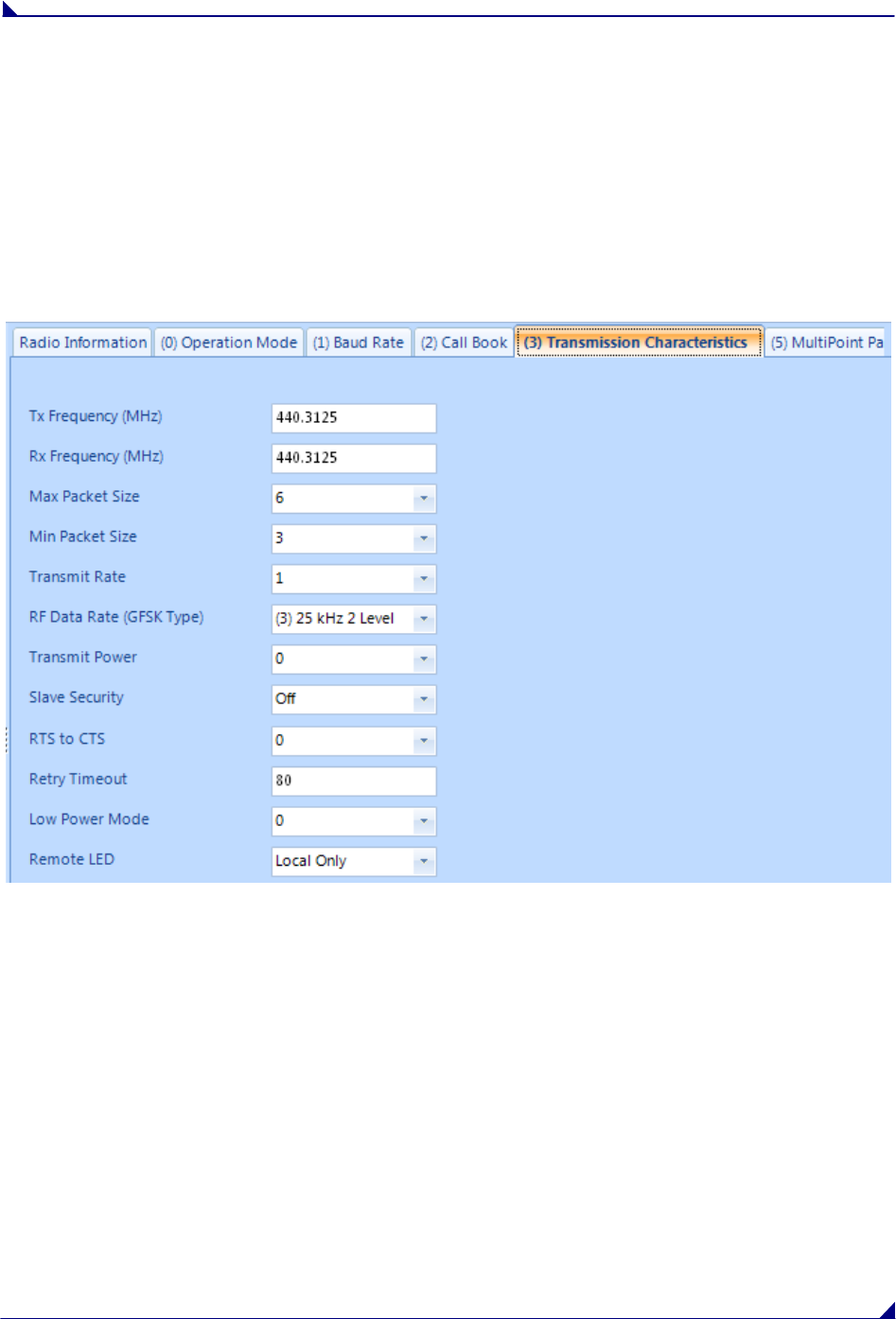
LRS400S Data Transceiver Users Manual
LUM0025AA Rev A Version 1.0 16
Radio Transmission Characteristics
The Edit Radio Transmission Characteristics option allows the user to modify several different parameters
in the transceiver. Many of these parameters must be maintained throughout the network for proper
functionality.
Note: This menu is only for the sophisticated user who has a good understanding of the principles of
radio data transmission.
The settings for the Slave(s) not determined by the Master are RF Xmit Power, Slave Security, Retry
Time Out and Hop Table Size, Hop Table Version, and Hop Table Offset.
Note: Above image from LRS455. Configuration will be the same.
Edit Radio Transmission Characteristics
SETTING XMIT AND RCV FREQUENCIES
The 400MHz Data Transceiver has the option to operate in a Frequency Division Duplex mode by
transmitting on one frequency and receiving on another.
The LRS400S transceivers must be programmed to operate on the appropriate frequency. To program
the transceiver for single channel operation, enter the frequency, in Megahertz, into the TX and RX
Frequency slots.
If the transceivers are to operate in Frequency Division Duplex, the TX and RX Frequency slots will have
different frequencies assigned.

LRS400S Data Transceiver Users Manual
LUM0025AA Rev A Version 1.0 17
(1) AND (2) MAX PACKET SIZE AND MIN PACKET SIZE
The Max and Min Packet Size settings and the RF Data Rate determine the number of bytes in the
packets. Throughput can be enhanced when packet sizes are optimized.
The following 3 tables provide the information to determine optimum setting values.
Minimum Packet Size Definition
Min Setting Min Packet Size
0 0
1 16
2 32
3 48
4 64
5 80
6 96
7 112
8 128
9 144
Maximum Packet Size (2 level FSK)
Max Setting Max Packet Size
0 32
1 48
2 64
3 80
4 96
5 112
6 128
7 135
8 135
9 135
Maximum Packet Size (4 level FSK)
Max Setting Max Packet Size
0 32
1 48
2 64
3 80
4 96
5 112
6 128
7 144
8 160
9 176
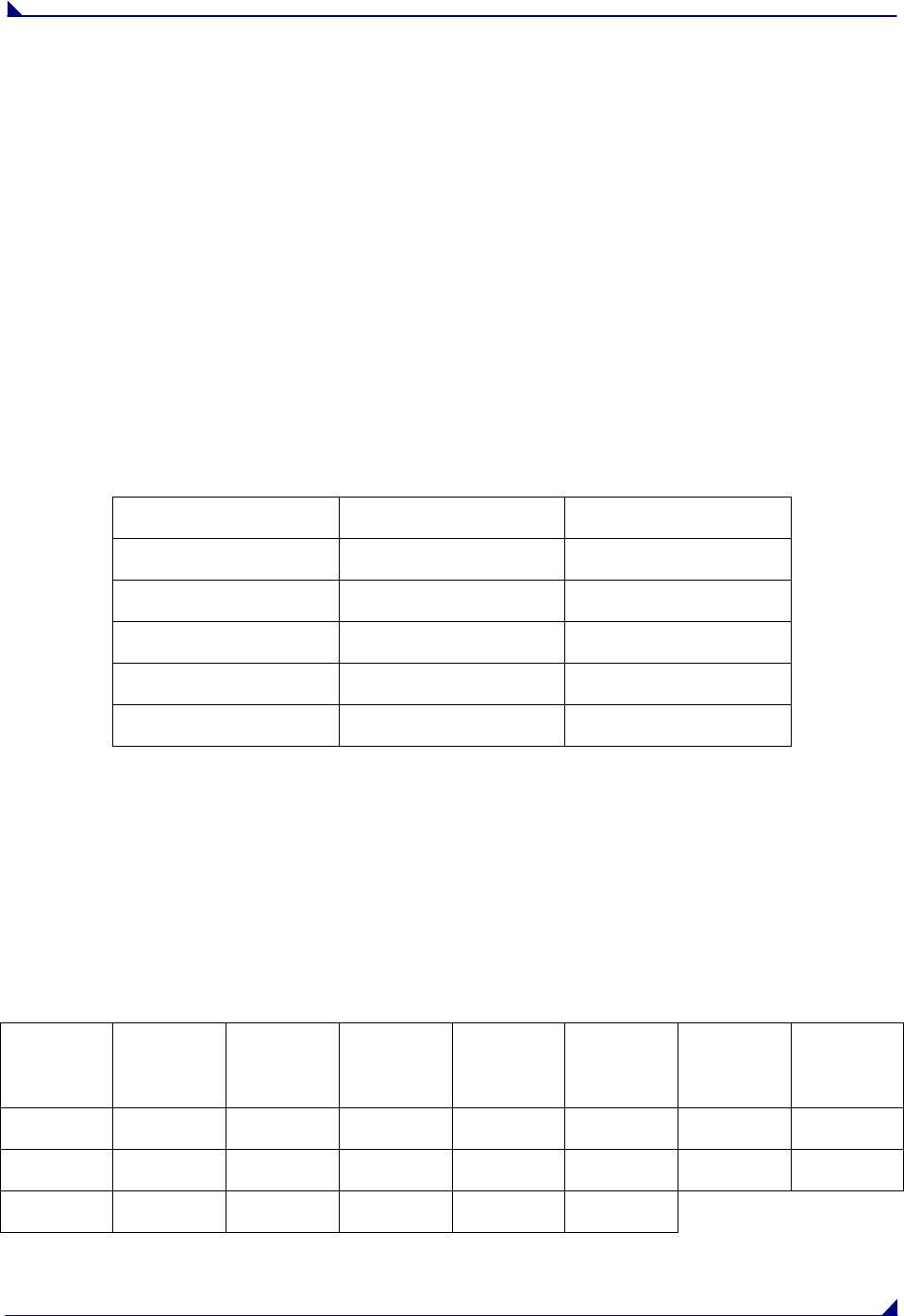
LRS400S Data Transceiver Users Manual
LUM0025AA Rev A Version 1.0 18
(3) XMIT RATE
FreeWave transceivers utilize a Master Transmit Beacon to provide low current consumption in the slave
radios. The slave radios will turn their receiver off when no data is being passed.
The Xmit Rate setting allows the duty cycle of the Master Transmit Beacon to be changed. A setting of 0
is the highest duty cycle and a setting of 9 is the lowest duty cycle.
(4) RF DATA RATE
FreeWave transceivers have five settings for the RF Data Rate (1, 2, 3, 4, 5 ). RF Data Rate should not
be confused with the serial port Baud Rate.
Setting 2 should be used when the transceivers are close together and data throughput needs to be
optimized. Setting 3 should be used when the transceivers are farther away and a solid data link is
preferred over data throughput.
Note: In MultiPoint networks, the RF Data Rate must be set identically in all transceivers. Any
transceiver with an RF Data Rate different from the Master will not establish a link.
In Point to Point networks the Master’s settings take precedence over the Slave.
RF Data Rate Setting Occupied Bandwidth Modulation Level
1 50kHz 2-level GFSK
2 25kHz 4-level GFSK
3 25kHz 2-level GFSK
4 12.5kHz 4-level GFSK
5 12.5kHz 2-level GFSK
(5)RF XMIT POWER
The RF Xmit Power parameter allows the user to control the output transmit power up to two watts
(+33dBm).
Note: For use in applications requiring greater than 70% transmit duty cycle, the LRS400S series of
radios must be attached to an appropriate heat sync.
The following table shows RF TX output versus the RF Xmit Power setting.
RF Xmit
Power RF TX
Power
(dBm)
RF Xmit
Power RF TX
Power
(dBm)
RF Xmit
Power RF TX
Power
(dBm)
RF Xmit
Power RF TX
Power
(dBm)
10 +33 7 +30 4 +27 1 +24
9 +32 6 +29 3 +26 0 +23
8 +31 5 +28 2 +25

LRS400S Data Transceiver Users Manual
LUM0025AA Rev A Version 1.0 19
(6) SLAVE SECURITY
Slave security is a feature which allows Slave transceivers to accept transmissions from a Master not
included in the Call Book. The default setting is 0 (Slave Security enabled) which means, only Masters in
the Slaves’ Call Book may link to that Slave.
Slave Security may be disabled (setting of 1) allowing any Master to call the Slave. Slave Security has no
effect in Point-to-MultiPoint networks where the Network ID is not set to 255.
Slave Security must be set to 1 when the unit is operating in Mode 6 Slave/Master switchable or a Point-
to-Point network where the Slave may need to accept calls from more than 10 different Masters. When
Slave Security is set to 1, the transceiver will accept calls from any other FreeWave transceiver.
Additional network security measures may be taken to prevent unauthorized access, such as changing
default settings for FreqKey, Hop Table or Frequency Zones.
(7) RTS TO CTS
Menu selection RTS to CTS in the Radio Parameters menu provides the option of allowing the RTS line
on the Master transceiver to control the CTS line of the Slave. This pass-through control can be enabled
in both Point-to-Point and Point-to-MultiPoint. In MultiPoint networks, the Master RTS line will control all
Slaves’ CTS lines. When enabled, the CTS line ceases to function as flow control. It is not recommended
to enable this feature when operating at RS-232 speeds above 38.4kB.
The default setting of 0 disables this function, where as a setting of 1 enables RTS-CTS control.
RTS-CTS setting 2 is described in detail in the application note #5437 DTR to CTS Line Alarm Feature.
With an RTS to CTS setting of 1, the Master senses the RTS line prior to all scheduled packet
transmissions. If the state has changed, the Master will then transmit a message to the Slave with the
new status. This transmission will occur regardless of data being sent. If data is ready to be sent, the
RTS status message will be sent in addition to the data. In Point-to-Point mode, the Master will continue
sending the new status message until it receives an acknowledgment from the Slave. In MultiPoint mode,
the Master will repeat the message the number of times equal to the Master Packet Repeat value in the
MultiPoint Parameters menu.
Master transmit times are completely asynchronous to the occurrence of any change of the RTS line; the
latency time from RTS to CTS is variable. The Max and Min Packet Size parameters in the Radio
Parameter menu determine this duration. Setting both parameters to their maximum value of 9 will
produce a maximum latency time of approximately 21 ms. At the minimum settings for Max and Min
Packet Size (0), the time will be approximately 5.9 ms. Please note that this latency can increase
significantly if packets are lost between the Master and Slave. In Point-to-MultiPoint mode, there is no
absolute guarantee that the state change will be communicated to all Slaves in the unlikely event that all
repeated packets from the Master do not get through to all Slaves.
Note: If DTRConnect is enabled and set to 2, the RTS to CTS feature will not work.
Note: If the DTRConnect is enabled and set to 1, RTS to CTS mode takes precedence over the
functionality of the CTS line on the Slave relating to the DTRConnect feature.
Note: The RTS to CTS option is only available in RS232 mode.
(8) RETRY TIME OUT
The Retry Time Out parameter in a Slave sets the delay the unit will wait before dropping the connection
to a Master in MultiPoint mode. The factory default is set at the maximum of 255. The maximum setting
means that if 1 packet in 255 is sent successfully from the Master to the Slave, the link will be maintained.
The minimum setting is 8. This allows a Slave to drop a connection if less than 1 in 8 consecutive packets
is successfully received from the Master.

LRS400S Data Transceiver Users Manual
LUM0025AA Rev A Version 1.0 20
On the other hand, the function in the Master is effectively the same. With a setting of 255, the Master
will allow a Slave to stay connected as long as 1 packet in 255 is successfully received at the Master.
The Retry Time Out parameter is useful when a MultiPoint network has a roving Master or Slave(s). As
the link gets weaker, a lower setting will allow a poor link to break in search of a stronger one.
Note: Setting Retry Time Out to 20 is recommended in areas where several FreeWave networks exist.
This setting will allow Slaves to drop the connection if the link becomes too weak, while at the
same time prevent errant disconnects due to interference from neighboring networks.
While intended primarily for MultiPoint networks, the Retry Time Out parameter may also be modified in
Point-to-Point networks. However, the value in Point-to-Point mode should not be set to less than 151.
(9) LOWPOWER MODE
The Lowpower Mode feature allows a MultiPoint Slave to consume less power. When set to 2 through 31,
the transceiver will sleep between slots. For example, at a setting of 2 the transceiver sleeps 1 out of 2
slots; at a setting of 3 the transceiver sleeps 2 out of 3 slots, and so on.
The following table shows the changes at different Lowpower Mode settings. The actual current draw
depends on many factors. The table below gives only a qualitative indication of supply current savings. A
low number reduces latency and a high number reduces current consumption.
Setting Description
0 Lowpower, disabled
1 LEDs dimmed, transceiver remains awake, transceiver is listening to the
Master’s transmissions on every slot, and transceiver’s data port is shut
down if the RTS line is deasserted (low). In this case, the transceiver
needs to be awakened before it will be able to send data to the Master.
2 LEDs dimmed, transceiver sleeps every other slot
3 LEDs dimmed, transceiver sleeps 2 of 3 slots
4-31 LEDs dimmed, transceiver sleeps the number of slots corresponding to
the setting. For example, with a setting of 31 the transceiver sleeps 30 of
31 slots.
IMPORTANT NOTES
1. Lowpower Mode is used only in MultiPoint Slaves using serial protocol. Power savings occur only
when the Slave is linked. There are no power savings when the Slave is transmitting data.
Lowpower Mode is of little value when a Slave has a constant, high throughput. MCUSpeed must
be set to ‘0’ and RF Data Rate must be set to ‘3’ for Lowpower Mode to operate properly.
2. To communicate to an RS232 port of a transceiver that is in Lowpower Mode, the RTS line must
be held high to wake it up. The transceiver will wake up within approximately 20 milliseconds of
when RTS goes high.
3. If the RTS line on the Slave is held high, the transceiver will remain in normal operation
regardless of the Lowpower Mode setting. Once RTS is dropped the transceiver reverts to the
Lowpower Mode.
If the transceiver has the DTRConnect option set to 1 or 2 and if the Lowpower Mode enabled (set to 1-
31), the RTS line on the transceiver must be asserted for the ‘DTRConnect’ feature to operate properly.
Current Draw
More
Less

LRS400S Data Transceiver Users Manual
LUM0025AA Rev A Version 1.0 21
(C) REMOTE LED
This setting enables the user to connect Remote LED’s through the diagnostics port.
Setting Description Notes
0 Board LED’s Default. Only on board LEDs are enabled.
1 Board and Remote LED’s Onboard LED’s are enabled as well as
Remote LED’s through the Diagnostic port.
2 Remote LED’s
On board LED’s are disabled. Remote LED’s
are enabled through the Diagnostic port.
Note: When using Remote LED’s the center (TX) LED will not turn Green when in Setup mode. This line
is not pinned out.
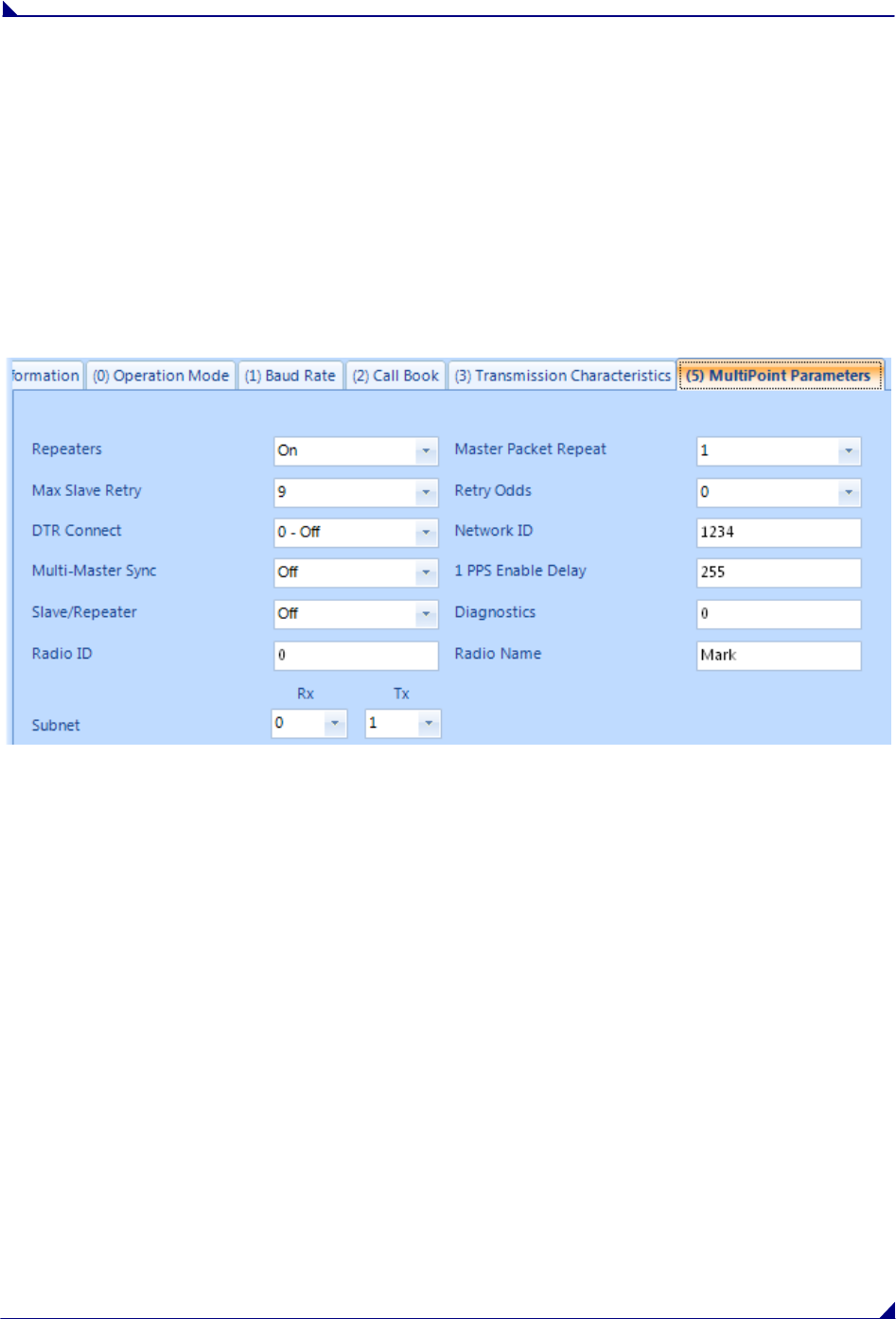
LRS400S Data Transceiver Users Manual
LUM0025AA Rev A Version 1.0 22
MultiPoint Parameters
When installing MultiPoint networks it is important to do some up front planning. Unlike Point-to-Point
networks, a Point-to-MultiPoint network requires several parameters are set consistently on all
transceivers in the network. This includes RF data rate and Min and Max Packet Size.
Note: If several independent MultiPoint networks are to be located in close proximity the planning
becomes more critical. In such cases, it becomes very important to include as much frequency
and time diversity as possible through use of different Min and Max Packet Size. In some
instances the use of the MultiMaster Sync option may be required.
Edit MultiPoint Parameters
(0) REPEATERS
The Repeaters selection must be set to On if a repeater is to be used in the network. However, if the
network will not utilize a repeater, FreeWave recommends setting Repeaters to Off to provide higher
throughput.
(1) MASTER PACKET REPEAT
In a Point-to-MultiPoint network, Slaves do not acknowledge transmissions from the Master. If Slaves did
acknowledge all data transmissions, in a large network, the Master would soon become overwhelmed
with acknowledgments from the Slaves. Without acknowledgements, 100% confidence every Slave has
received every packet cannot be met. To address this issue, the user may modify the Master Packet
Repeat setting, assigning a value between 0 (the packet is transmitted once) to 9 (the packet is
transmitted 10 times). For networks with solid RF links, this parameter should be set to a low value such
as 0 or 1. If a network has some weak or marginal links it should be set with higher values. If a Slave
receives a good packet from a Master more than once it will discard the repeated packets
Increasing the Master Packet Repeat setting will increase the probability of a packet getting through, but
will also increase latency in the network because each packet from the Master is being sent multiple
times. Therefore, it is important to find the optimal mix between network robustness, throughput, and
latency. In general, a setting of 0 to 1 will work well for most well designed licensed band networks.
Note: The Master Packet Repeat may be set to 0 if the user software is capable of, or requires
acknowledgment. In this case if a packet sent by the Master and not received by the Slave, the
user software will control the retries as needed.

LRS400S Data Transceiver Users Manual
LUM0025AA Rev A Version 1.0 23
(2) MAX SLAVE RETRY
The Max Slave Retry setting defines how many times (0 to 9) the Slave will attempt to retransmit a packet
to the Master before beginning to use a back-off algorithm (defined by the Retry Odds setting). Slave
retries will stop when an acknowledgement is received from the Master.
(3) RETRY ODDS
While packets transmitted from the Master to the Slaves in a MultiPoint network are not acknowledged,
packets transmitted from Slaves to the Master are. It is possible, that more than one Slave will attempt to
transmit to the Master at the same time. Therefore, it is important that a protocol exists to resolve
contention for the Master between Slaves. This is addressed through parameters (2) Max Slave Retry
and (3) Retry Odds. Once the Slave has unsuccessfully attempted to transmit the packet the number of
times specified in Max Slave Retry, it will attempt to transmit to the Master on a random basis. The Retry
Odds parameter determines the probability that the Slave will attempt to retransmit the packet to the
Master; a low setting will assign low odds to the Slave attempting to transmit. Conversely, a high setting
will assign higher odds. An example of how this parameter might be used would be when considering two
different Slaves in a MultiPoint network, one with a strong RF link and the other with a weak RF link to the
Master. It may be desirable to assign higher Retry Odds to the Slave with the weaker link to give it a
better chance of competing with the closer Slave(s) for the Master's attention.
When Retry Odds = 0, after the Slave has exhausted the number of retries set in the Max Slave Retry
parameter and still not gained the Master’s attention, the Slave’s data buffer will be purged.
(4) DTR CONNECT
With the setting of 0 in the Slave, the transceiver will transmit when RS232 data is received. A setting of
1 will form a Point-to-Point link with the Master when the DTR line is high. With a setting of 2, the
transceiver will transmit in bursts. This mode is valuable when a network has many low data rate devices
and it is desirable to increase overall network capacity.
Note: If ‘DTRConnect’ is set to 1 and the ‘RTS to CTS’ function is enabled on the radio, then ‘RTS to
CTS’ takes precedence over ‘DTRConnect’.
Note: If ‘DTRConnect’ is set to ‘2’ and ‘RTS to CTS’ is enabled, then ‘RTS to CTS’ is ignored. The
transceiver has two separate transmit and receive user data buffers. These buffers are 2 Kbytes
each. In case of a buffer overflow, the transceiver will output unpredictable data.
(6) NETWORK ID
Network ID allows MultiPoint networks to be established without using the Call Book. The default setting
of 255 enables the Call Book. To enable Network ID the value must be set between 0 and 4095
(excluding 255). Since Network ID does not use serial numbers, MultiPoint Masters may be replaced
without reprogramming all of the Slaves in the network. Slaves will link with the first Master that it hears
that has a matching Network ID. The Network ID function should be used in conjunction with the Subnet
ID feature (If necessary).
Without having the serial numbers in the Call Book, a Slave may establish communications with different
Masters, though not at the same time. This is very useful in mobile MultiPoint applications.
(8) MULTIMASTER SYNC
MultiMaster Sync is reserved for applications, in both Point-to-Point and MultiPoint modes, with
concentrations of Master units where it is necessary to reduce interference between the Masters. Please
contact FreeWave Technologies for more information.
(9) 1 PPS ENABLE/DELAY
The 1 PPS Enable/Delay option allows the radio network to propagate a 1PPS signal from the Master to
all Slaves in a MultiPoint network. When this parameter is enabled a properly generated pulse applied on

LRS400S Data Transceiver Users Manual
LUM0025AA Rev A Version 1.0 24
the DTR line of the Master will provide a 1 PPS pulse on the CD line of any Slave in the network. To use
the 1 PPS Enable/Delay feature the steps outlined below must be followed:
1PPS Enable/Delay Setup:
1. The 1 PPS Enable/Delay parameter must be set to 0 in the Master.
2. The Master must have a 1 PPS pulse on the DTR pin.
3. The 1 PPS Enable/Delay parameter on the Slaves must be enabled. Slaves are calibrated at the
factory.
Calibrating a Slave in 1PPS Enable/Delay mode
1. Trigger an oscilloscope on the 1 PPS pulse on the DTR line of the Master.
2. Monitor the CD line of the Slave.
3. If the timing on the Slave differs from the Master it may be adjusted via the value in the Slave's 1
PPS Enable/Delay parameter. The difference in time between each incremental integer value is
542.534nS. Changing the parameter to higher values decreases the Slave time delay and
changing the parameter to lower values increases the time delay.
When properly calibrated the CD line of a Slave radio will output a pulse that goes high for about 2mS in
sync with the 1 PPS pulse on the Master radio. The output on the Slave will occur within 20
microseconds of the input to the Master.
Note: When 1 PPS is enabled, the Master must have a 1 PPS pulse on its DTR pin, otherwise the RF
network will not function.
(A) SLAVE/REPEATER
Normally a repeater does not have the ability to provide data on the data port. When this capability is
necessary Slave/Repeater should be set to On. When using Slave/Repeater, the baud rate and
communication protocol must match the end device.
(B) DIAGNOSTICS
This option provides diagnostics data to be viewed at the Master in parallel with application data. The
diagnostic program MUST be run from the Master transceiver. Diagnostics requires the following:
1. Diagnostics set to (1 to 128) in the Master.
2. A second computer or serial connection to run the diagnostics software.
3. A diagnostics cable. (Available from FreeWave Technologies.)
4. Diagnostics software. (Available on the User Manual and System Tools CD.)
For more information on Diagnostics, please contact FreeWave Technical Support at (303) 381-9200.
(C) SUBNET ID
The Subnet ID function only works in MultiPoint Networks utilizing the Network ID option. In a MultiPoint
Network, a Slave or Repeater will connect with the first Repeater or Master that it hears with the same
Network ID. However, where communications need to be forced to follow a specific path the Subnet ID is
quite useful. Subnet ID is particularly helpful to force two Repeaters in the same network to operate in series
rather than in parallel, or if desired, to force Slaves to communicate to a specific Repeater for load balancing
purposes. Two components exist with regard to the Subnet ID:
1. Rcv Subnet ID. This setting identifies which transceiver a Repeater or Slave will listen to.
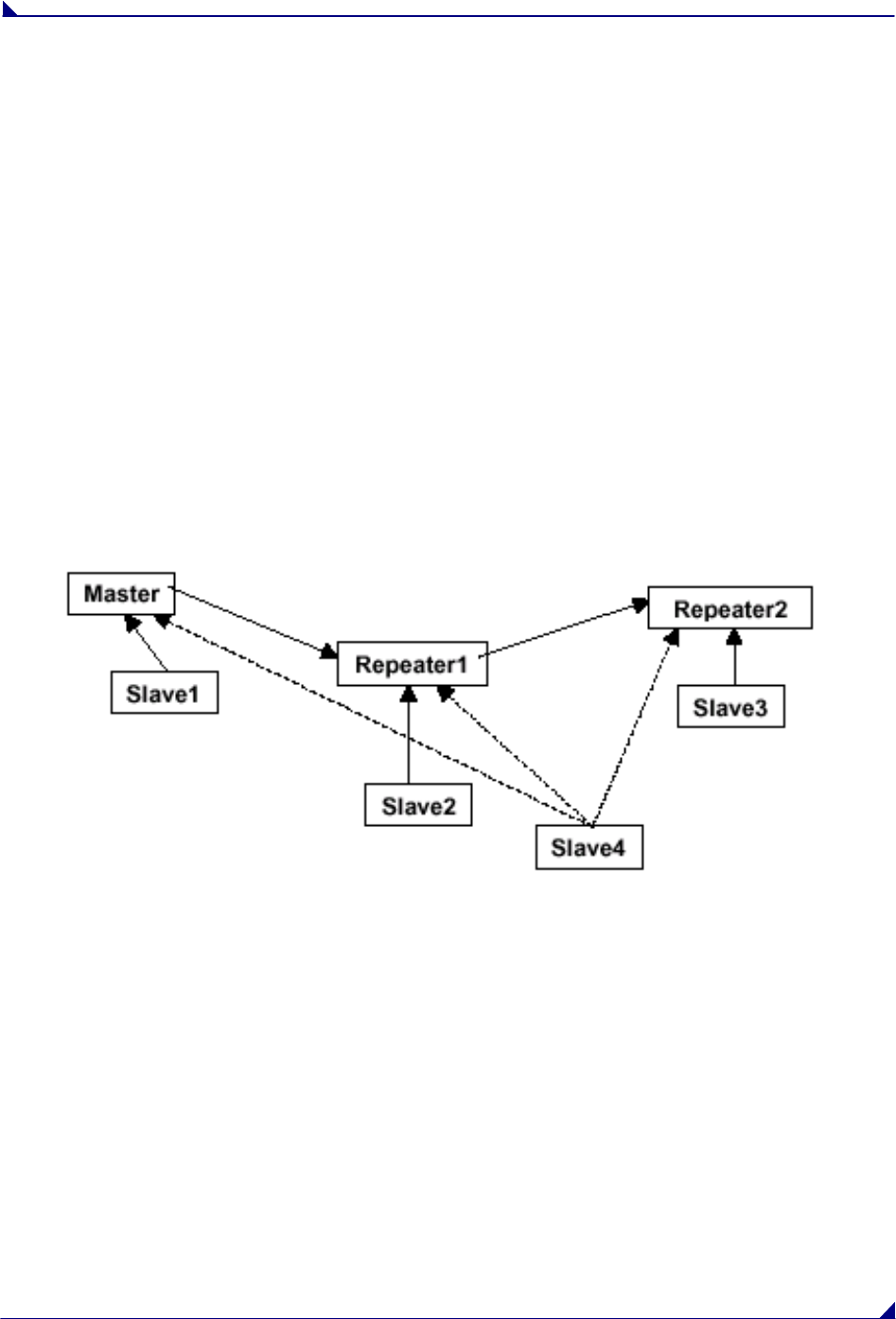
LRS400S Data Transceiver Users Manual
LUM0025AA Rev A Version 1.0 25
2. Xmit Subnet ID. This setting identifies the ID on which this device transmits, and in turn which
devices will listen to it. The Xmit Subnet ID parameter is relevant for MultiPoint Repeaters only.
The default (disable) setting for both Rcv and Xmit is F.
Notes: A Master will always transmit and receive on 0. Changing these settings on the Master is not
recommended, under normal circumstances.
In some MultiPoint Networks, the FreqKey will be at the same setting for all transceivers. In other
networks, where parallel Repeaters are introduced, the FreqKey value will need to change. See
FreqKey and Repeater Frequency sections earlier in this manual for more information.
If both Rcv Subnet ID and Xmit Subnet ID are set to 0 the Subnet ID will show Roaming in the
menu. This setting will allow a mobile Slave to roam from subnet to subnet and possibly from
network to network.
This drawing depicts a Network in which Subnet IDs are used to force communications. In this example,
Repeater1 must talk directly to the Master; Repeater2 must talk directly to Repeater1. Slaves 1, 2, and 3
are forced along the direction of the solid lines. Slave4 may link to the first Master or Repeater it hears.
The respective Subnet ID diagram and settings are shown below.
(D) RADIO ID
Option (D) allows a transceiver to be designated with an arbitrary, user selectable, 4 digit number which
identifies the transceiver in diagnostics mode.
(E) LOCAL ACCESS
Local Access is not to be used at this time.
(G) RADIO NAME
Option (G) allows the user to set a unique 20 character Radio name.
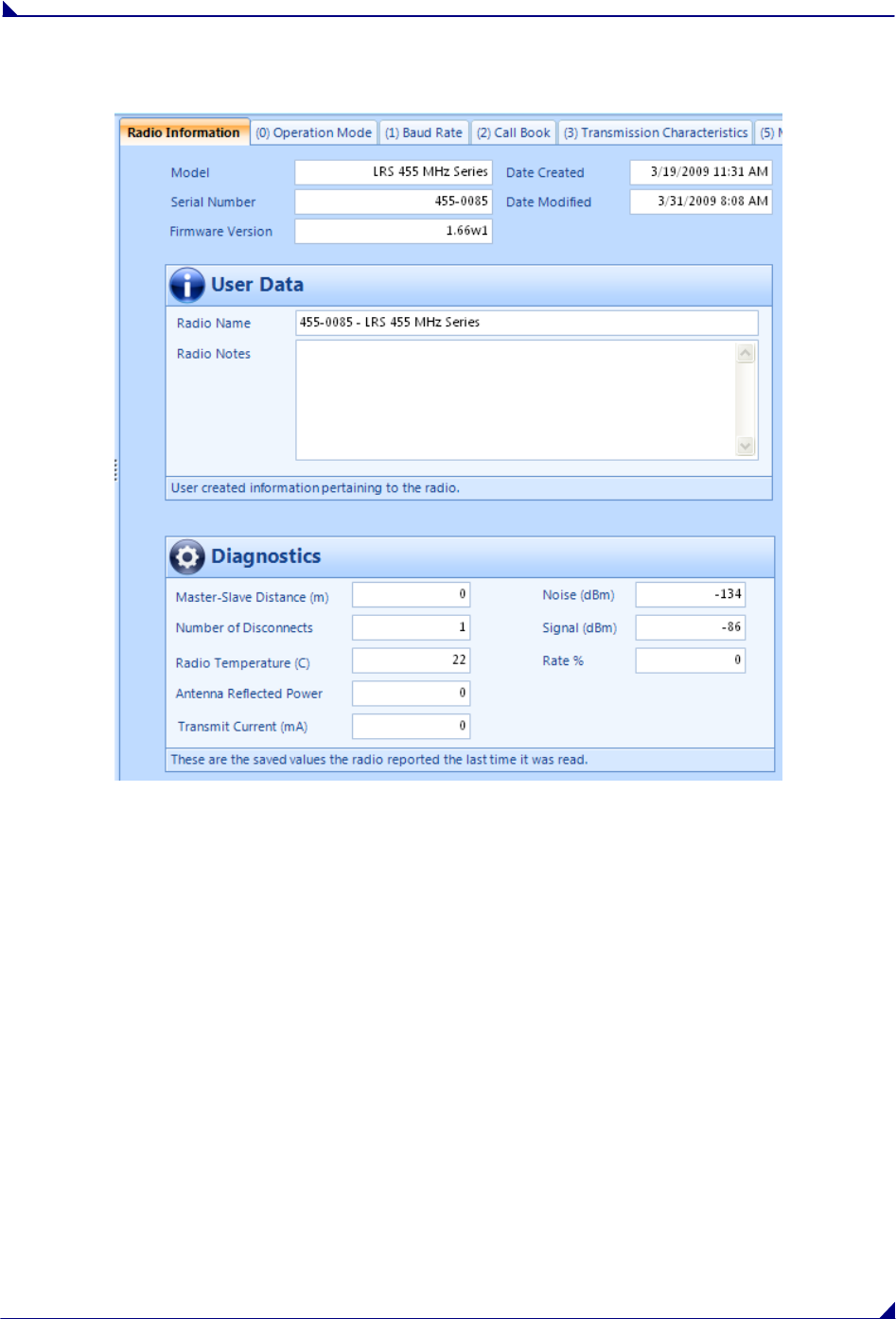
LRS400S Data Transceiver Users Manual
LUM0025AA Rev A Version 1.0 26
Radio Information
Radio Statistics in the Main Menu allows the user to view data transmission statistics gathered by the
transceiver during the most recent session. This is valuable when the user needs to know the signal
strength and noise levels of the link. Statistics are gathered during each data link and are reset when the
next link begins. See display below.
NUMBER OF DISCONNECTS
Any time the link between the Master and the Slave is broken and the radios lose Carrier Detect, it is
recorded in the Number of Disconnects value. The value indicates the total number of disconnects that
have occurred from the time the transceiver is powered on until the radio is put into Setup mode. Under
ideal operating conditions, the number of disconnects should be 0. One or more disconnects may indicate
a weak link, the presence of severe interference problems or loss of power to any of the radios in the link.
ANTENNA REFLECTED POWER
This is a measurement of the transmitted power that is reflected back into the transceiver from
mismatched antennas or cables, or loose connections between the transceiver and antenna. A reading
of 0-5 is good; 5-30 is acceptable; 30+ indicates that the connections should be inspected for loose
connections and cable quality.
AVERAGE NOISE LEVEL
The average noise level indicates the level of background noise and interference at this transceiver. The
number is an average of the noise levels measured at each frequency in the transceiver’s frequency hop

LRS400S Data Transceiver Users Manual
LUM0025AA Rev A Version 1.0 27
table. The individual measurement values at each frequency hop channel are shown in the frequency
table. Pressing the Enter key when the Radio Statistics menu is displayed, accesses the frequency table.
Ideally, noise levels should be below -120 dBm units and the difference between the average signal level
and average noise level should be 26 dB or more. Noise levels significantly higher than this are an
indication of a high level of interference that may degrade the performance of the link. High noise levels
can often be mitigated with band pass filters, antenna placement or antenna polarization.
AVERAGE SIGNAL LEVEL
The average signal level indicates the level of received signal at this transceiver. For each of these, the
signal source is the transceiver that transmits to it. The number is an average of the received signal levels
measured at each frequency in the transceiver's frequency hop table. The individual measurement values
at each frequency hop channel are shown in the frequency table. Pressing the Enter key when the Radio
Statistics menu is displayed accesses the frequency table. For a reliable link, the margin should be at
least 26 dB. Low Average Signal Levels can often be corrected with higher gain antennas and better
antenna placement.
Note: Please consult the install manual for antenna and FCC requirements.
OVERALL RCV RATE (%)
The Overall Receive Rate measures the percentage of data packets that were successfully transmitted
from the Master to the Slave on the first attempt. A number of 75 or higher indicates a robust link that will
provide very good performance even at high data transmission rates. A number of 15 or lower indicates a
weak or marginal link that will provide lower data throughput.
RADIO TEMPERATURE
The Radio Temperature value is the current operating temperature of the transceiver in degrees Celsius.
For proper operation, a FreeWave transceiver must be in the temperature range of -30° to +60° C.
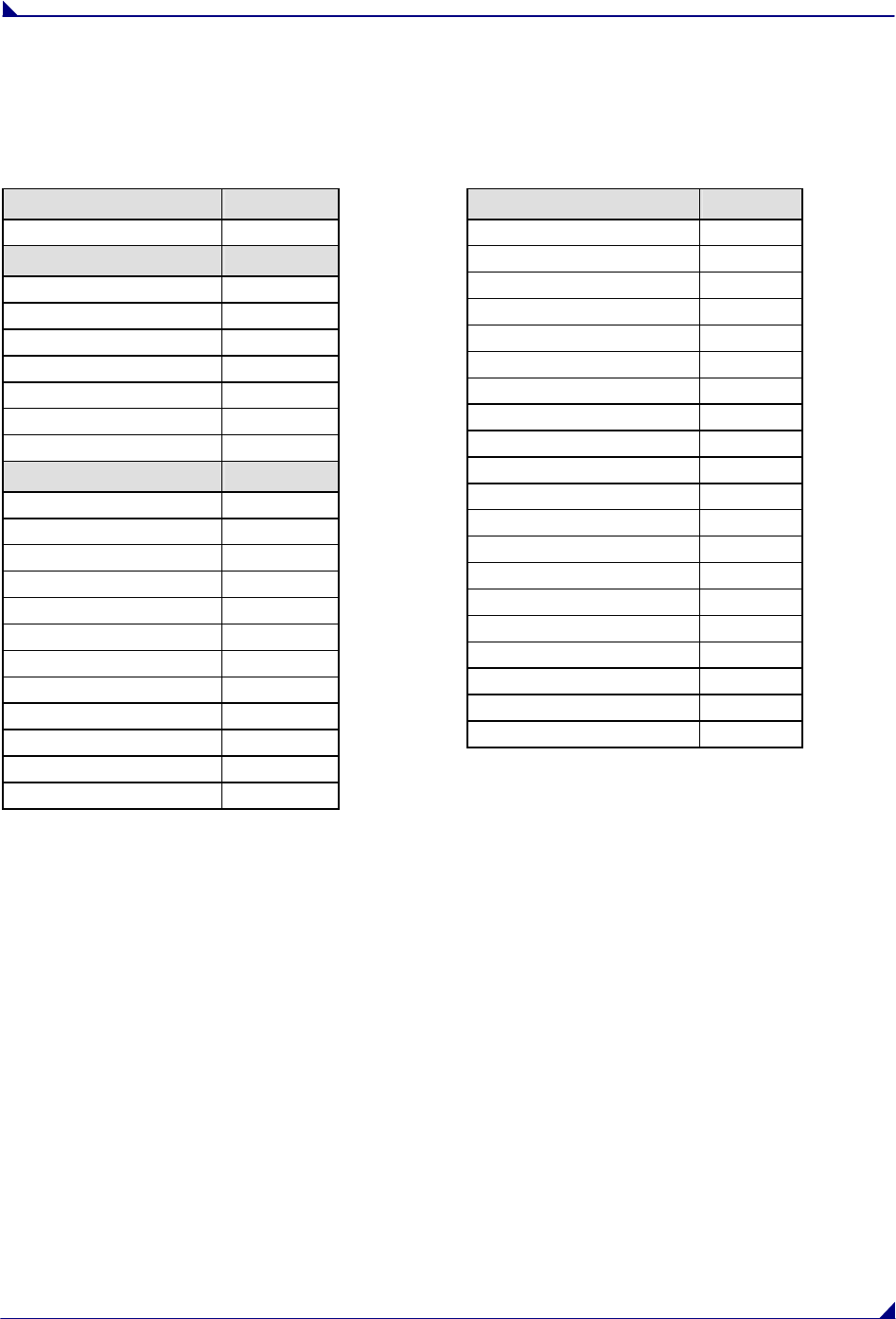
LRS400S Data Transceiver Users Manual
LUM0025AA Rev A Version 1.0 28
Factory Default Settings
FreeWave 415MHz transceivers are shipped from the factory with the following Default Settings:
Operation Mode Default
Point to Point Slave 1
Set Baud Rate Default
Baud Rate 19200
(A) Data Parity 0
(B) Modbus RTU 0
(C) RS232/485 0
(D) Setup Port 3
(E) TurnOffDelay/OnDelay 0/0
(F) Flow Control 0
Radio Parameters Default
(1) MAX PACKET SIZE 9
(2) MIN PACKET SIZE 1
(3) XMT RATE 1
(4) RF DATA RATE 5
(5) RF XMT POWER 10
(6) SLAVE SECURITY 0
(7) RTS TO CTS 0
(8) RETRY TIMEOUT 255
(9) LOW POWER MODE 0
(A) High Noise 0
(B) MCU Speed 0
(C) Remote LED 0
MultiPoint Parameters Default
(1) MASTER PACKET REPEAT 0
(2) MAX SLAVE RETRY 9
(3) RETRY ODDS 0
(4) DTR CONNECT 0
(6) NETWORK ID 255
(7) RESERVED
(8) MULTI MASTER SYNC 0
(9) 1 PPS ENABLE DELAY 255
(B) DIAGNOSTICS 0
(D) RADIO ID Not Set

LRS400S Data Transceiver Users Manual
LUM0025AA Rev A Version 1.0 29
Additional Transceiver information
This section contains additional important information about FreeWave transceivers. The following topics
are included in this section:
Operational RS422 and RS-485 Information
RS232 Pin Assignments
OEM Board Pin Assignments
Operational RS-422 and RS-485 Information
For both RS-422 and RS-485, the FreeWave transceiver can drive 32 standard unit loads and loads the
bus with only 1/8 unit load. This means the user can tie up to 256 devices on the bus if all of the line
receivers have 1/8 unit load.
RS-422 is used for 4-wire or full duplex communication with one Master and multiple Slaves. The
FreeWave Master transceiver keeps the line driver asserted at all times. The maximum line length is
4,000 feet using 2, 120 ohm twisted pair cables with a 5th wire for data common.
RS-485 full duplex using 4 wire plus common is the same as RS-422, except the system can have
multiple Masters on the bus.
The most common operation of RS-485 is a two-wire comprised of a 120 ohm impedance single twisted
pair. In this system the loading of the FreeWave transceiver is as described above which allows up to 256
1/8 unit load units on the bus. Maximum line length is also 4,000 feet with a third wire required for data
common. The FreeWave transceiver will check the line to be certain no other device is transmitting before
enabling the line driver for data transmission.
When setting the transceiver to RS-485, enable Modbus and set Master Packet Repeat to 3 in the
transceiver(s) that will use RS-485. Also set TurnOff Delay to 4.
The TurnOffDelay setting in the menu is used to control the length of time the transmitter driver stays
asserted after data transmission has finished. This is needed to allow the last transmitted character to
reach the end of a long line and is normally set to one character length of time. This setting also allows 3
complete reflections to the end of the line to ensure the ringing on the line has fully dampened before
releasing the bus to another device. Shorter line lengths may use shorter delays, but four one-quarter-
character delay times are recommended. In Modbus, a TurnOffDelay setting of 0 will cause internal timing
errors.
There is no provision for hand shaking in any of the above modes of operation, so data rates of 57.6
KBaud and above are not recommended without a protocol that can handle error detection properly.
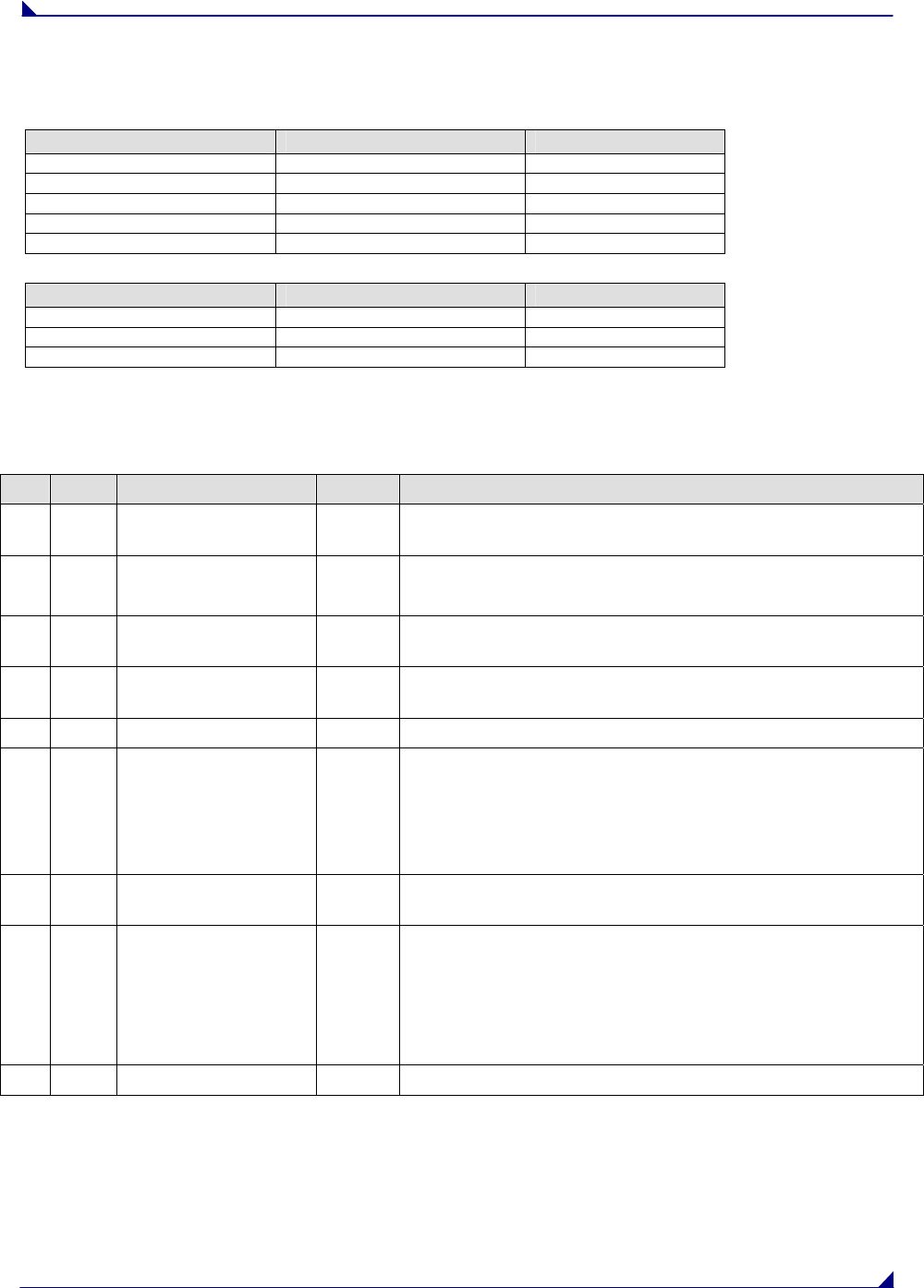
LRS400S Data Transceiver Users Manual
LUM0025AA Rev A Version 1.0 30
RS-422 AND RS-485 FULL DUPLEX PIN-OUTS
Function Bare Board Pin Number DE-9 Pin Number
RX+ 7 3
RX- 9 7
TX+ 5 2
TX- 10 8
Signal Ground 4 or 6 5
RS-485 HALF DUPLEX PIN-OUTS
Function Bare Board Pin Number DE-9 Pin Number
Wire to both pins for Bus + Short 5 and 7 Short 2 and 3
Wire to both pins for Bus - Short 9 and 10 Short 7 and 8
Signal Ground 4 or 6 5
RS232 Pin Assignments
Pin Assignment Signal Definition
1 CD Carrier Detect Output Used to show an RF connection between transceivers.
2 TX Transmit Data Output Used to transmit data bits serially from the transceivers to the
system device.
3 RX Receive Data Input Used to receive data bits serially from the system device
connected to the transceivers.
4 DTR Data Terminal Ready Input Used only in transceivers in Point-to-Point Slave/Master
switchable mode or for DTR Connect.
5 GND Ground Signal return for all signal lines shared with Pin 9.
6 DSR Data Set Ready Output Always high when the radio is powered from the 2.5mm
power connector. Indicated power is on to the radio. Also,
this pin can be used for +12Volts when powering the
transceivers directly through the RS-232 port.
Note: This is not used on the OEM module.
7 RTS Request to Send Input The transceiver does not recognize RTS for flow control. RTS
is used as a control line in RTS/CTS mode.
8 CTS Clear to Send Output This signal is used to tell the system device connected to the
transceiver that the transceiver is ready to receive data.
When asserted, the transceiver will accept data, when
deasserted the transceiver will not accept data. This should
always be used for data rates above 38.4KB or there will be a
risk of lost data if an RF link is not very robust.
9 GND Ground Signal return for all signal lines shared with Pin 5.
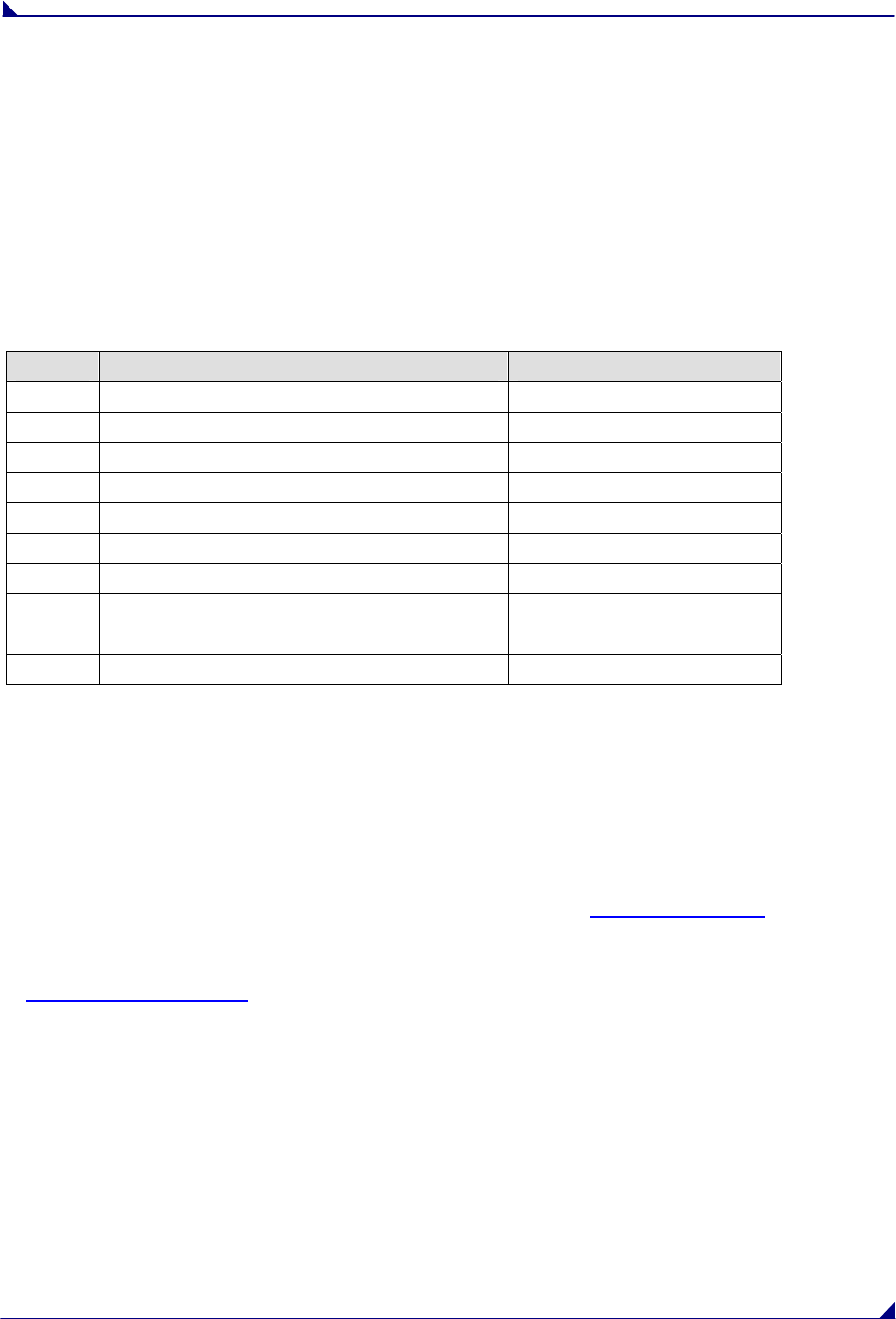
LRS400S Data Transceiver Users Manual
LUM0025AA Rev A Version 1.0 31
RF Board Pinout
The LRS400S series transceivers are available in both TTL and RS232 versions.
The TTL versions use reverse polarity from standard RS-232 at 0 to 5 Volt levels. All pin descriptions and
pin numbering are the same as the RS232 version. The RS232 versions use standard RS232 polarity and
voltage levels for all of the RS232 signal lines (DTR, Transmit Data, Receive Data, Carrier Detect, RTS,
and Clear to Send) and TTL standard polarity and voltage level for the Interrupt pin.
Pin 1: B+ Power input.
Pin 2: Interrupt (INT) – Input – A 0 volt level on this pin will switch the radio into Setup mode.
Pin Assignment Color on ACS3610xx cable
1 B+ input Red
2 Interrupt (temporarily ground to invoke menu) Brown
3 Data Terminal Ready (DTR) Orange
4 Ground Black
5 Transmit Data (TXD) Yellow
6 Ground Black
7 Receive Data (RXD) Green
8 Carrier Detect (DCD) Blue
9 Request to Send (RTS) Violet (purple)
10 Clear to Send (CTS) Gray
Note: Pin 1 on the board level transceiver is the pin farthest from the three LEDs and pin 10 is closest
to the LEDs.
FreeWave Technical Support
For up-to-date troubleshooting information check the Support page at www.FreeWave.com.
FreeWave provides Technical Support, Monday through Friday, 8:00 AM to 5:00 PM, Mountain Time
(GMT -7) Call us toll-free at 1-800-548-5616 or factory direct after hours at 303-381-9200 or email us
at moreinfo@FreeWave.com
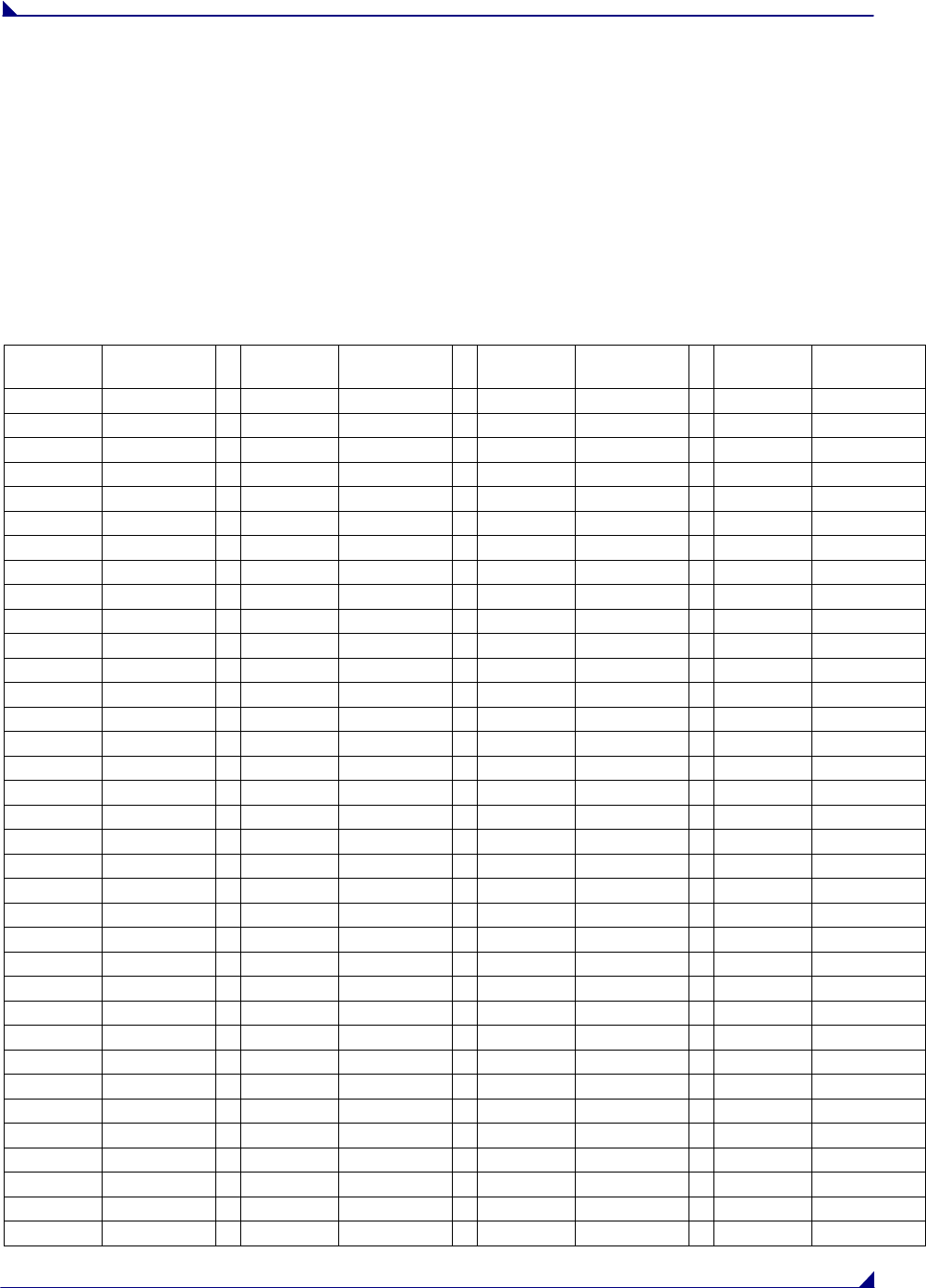
LRS400S Data Transceiver Users Manual
LUM0025AA Rev A Version 1.0 32
Frequency List
The LRS400S transceivers tune from 406.1MHz to 430MHz with a tuning resolution of 6.25KHz. This
gives a total of 3840 available channels. Using the license allowed frequency, the channel number can be
determined using the following formula.
Channel number = (FMHz - 390) / .00625
Note: This is an example list. If the required frequency is not listed use the FMHz
formula to obtain the appropriate channel number.
Channel
# Frequency
Channel
# Frequency
Channel
# Frequency
Channel
# Frequency
2576 406.1000 2910 408.1875 3260 410.3750 3610 412.5625
2578 406.1125 2920 408.2500 3270 410.4375 3620 412.6250
2580 406.1250 2930 408.3125 3280 410.5000 3630 412.6875
2590 406.1875 2940 408.3750 3290 410.5625 3640 412.7500
2600 406.2500 2950 408.4375 3300 410.6250 3650 412.8125
2610 406.3125 2960 408.5000 3310 410.6875 3660 412.8750
2620 406.3750 2970 408.5625 3320 410.7500 3670 412.9375
2630 406.4375 2980 408.6250 3330 410.8125 3680 413.0000
2640 406.5000 2990 408.6875 3340 410.8750 3690 413.0625
2650 406.5625 3000 408.7500 3350 410.9375 3700 413.1250
2660 406.6250 3010 408.8125 3360 411.0000 3710 413.1875
2670 406.6875 3020 408.8750 3370 411.0625 3720 413.2500
2680 406.7500 3030 408.9375 3380 411.1250 3730 413.3125
2690 406.8125 3040 409.0000 3390 411.1875 3740 413.3750
2700 406.8750 3050 409.0625 3400 411.2500 3750 413.4375
2710 406.9375 3060 409.1250 3410 411.3125 3760 413.5000
2720 407.0000 3070 409.1875 3420 411.3750 3770 413.5625
2730 407.0625 3080 409.2500 3430 411.4375 3780 413.6250
2740 407.1250 3090 409.3125 3440 411.5000 3790 413.6875
2750 407.1875 3100 409.3750 3450 411.5625 3800 413.7500
2760 407.2500 3110 409.4375 3460 411.6250 3810 413.8125
2770 407.3125 3120 409.5000 3470 411.6875 3820 413.8750
2780 407.3750 3130 409.5625 3480 411.7500 3830 413.9375
2790 407.4375 3140 409.6250 3490 411.8125 3840 414.0000
2800 407.5000 3150 409.6875 3500 411.8750 3850 414.0625
2810 407.5625 3160 409.7500 3510 411.9375 3860 414.1250
2820 407.6250 3170 409.8125 3520 412.0000 3870 414.1875
2830 407.6875 3180 409.8750 3530 412.0625 3880 414.2500
2840 407.7500 3190 409.9375 3540 412.1250 3890 414.3125
2850 407.8125 3200 410.0000 3550 412.1875 3900 414.3750
2860 407.8750 3210 410.0625 3560 412.2500 3910 414.4375
2870 407.9375 3220 410.1250 3570 412.3125 3920 414.5000
2880 408.0000 3230 410.1875 3580 412.3750 3930 414.5625
2890 408.0625 3240 410.2500 3590 412.4375 3940 414.6250
2900 408.1250 3250 410.3125 3600 412.5000 3950 414.6875

LRS400S Data Transceiver Users Manual
LUM0025AA Rev A Version 1.0 33
Channel
# Frequency
Channel
# Frequency
Channel
# Frequency
Channel
# Frequency
3960 414.7500 4420 417.6250 4880 420.5000 5340 423.3750
3970 414.8125 4430 417.6875 4890 420.5625 5350 423.4375
3980 414.8750 4440 417.7500 4900 420.6250 5360 423.5000
3990 414.9375 4450 417.8125 4910 420.6875 5370 423.5625
4000 415.0000 4460 417.8750 4920 420.7500 5380 423.6250
4010 415.0625 4470 417.9375 4930 420.8125 5390 423.6875
4020 415.1250 4480 418.0000 4940 420.8750 5400 423.7500
4030 415.1875 4490 418.0625 4950 420.9375 5410 423.8125
4040 415.2500 4500 418.1250 4960 421.0000 5420 423.8750
4050 415.3125 4510 418.1875 4970 421.0625 5430 423.9375
4060 415.3750 4520 418.2500 4980 421.1250 5440 424.0000
4070 415.4375 4530 418.3125 4990 421.1875 5450 424.0625
4080 415.5000 4540 418.3750 5000 421.2500 5460 424.1250
4090 415.5625 4550 418.4375 5010 421.3125 5470 424.1875
4100 415.6250 4560 418.5000 5020 421.3750 5480 424.2500
4110 415.6875 4570 418.5625 5030 421.4375 5490 424.3125
4120 415.7500 4580 418.6250 5040 421.5000 5500 424.3750
4130 415.8125 4590 418.6875 5050 421.5625 5510 424.4375
4140 415.8750 4600 418.7500 5060 421.6250 5520 424.5000
4150 415.9375 4610 418.8125 5070 421.6875 5530 424.5625
4160 416.0000 4620 418.8750 5080 421.7500 5540 424.6250
4170 416.0625 4630 418.9375 5090 421.8125 5550 424.6875
4180 416.1250 4640 419.0000 5100 421.8750 5560 424.7500
4190 416.1875 4650 419.0625 5110 421.9375 5570 424.8125
4200 416.2500 4660 419.1250 5120 422.0000 5580 424.8750
4210 416.3125 4670 419.1875 5130 422.0625 5590 424.9375
4220 416.3750 4680 419.2500 5140 422.1250 5600 425.0000
4230 416.4375 4690 419.3125 5150 422.1875 5610 425.0625
4240 416.5000 4700 419.3750 5160 422.2500 5620 425.1250
4250 416.5625 4710 419.4375 5170 422.3125 5630 425.1875
4260 416.6250 4720 419.5000 5180 422.3750 5640 425.2500
4270 416.6875 4730 419.5625 5190 422.4375 5650 425.3125
4280 416.7500 4740 419.6250 5200 422.5000 5660 425.3750
4290 416.8125 4750 419.6875 5210 422.5625 5670 425.4375
4300 416.8750 4760 419.7500 5220 422.6250 5680 425.5000
4310 416.9375 4770 419.8125 5230 422.6875 5690 425.5625
4320 417.0000 4780 419.8750 5240 422.7500 5700 425.6250
4330 417.0625 4790 419.9375 5250 422.8125 5710 425.6875
4340 417.1250 4800 420.0000 5260 422.8750 5720 425.7500
4350 417.1875 4810 420.0625 5270 422.9375 5730 425.8125
4360 417.2500 4820 420.1250 5280 423.0000 5740 425.8750
4370 417.3125 4830 420.1875 5290 423.0625 5750 425.9375
4380 417.3750 4840 420.2500 5300 423.1250 5760 426.0000
4390 417.4375 4850 420.3125 5310 423.1875 5770 426.0625
4400 417.5000 4860 420.3750 5320 423.2500 5780 426.1250
4410 417.5625 4870 420.4375 5330 423.3125 5790 426.1875
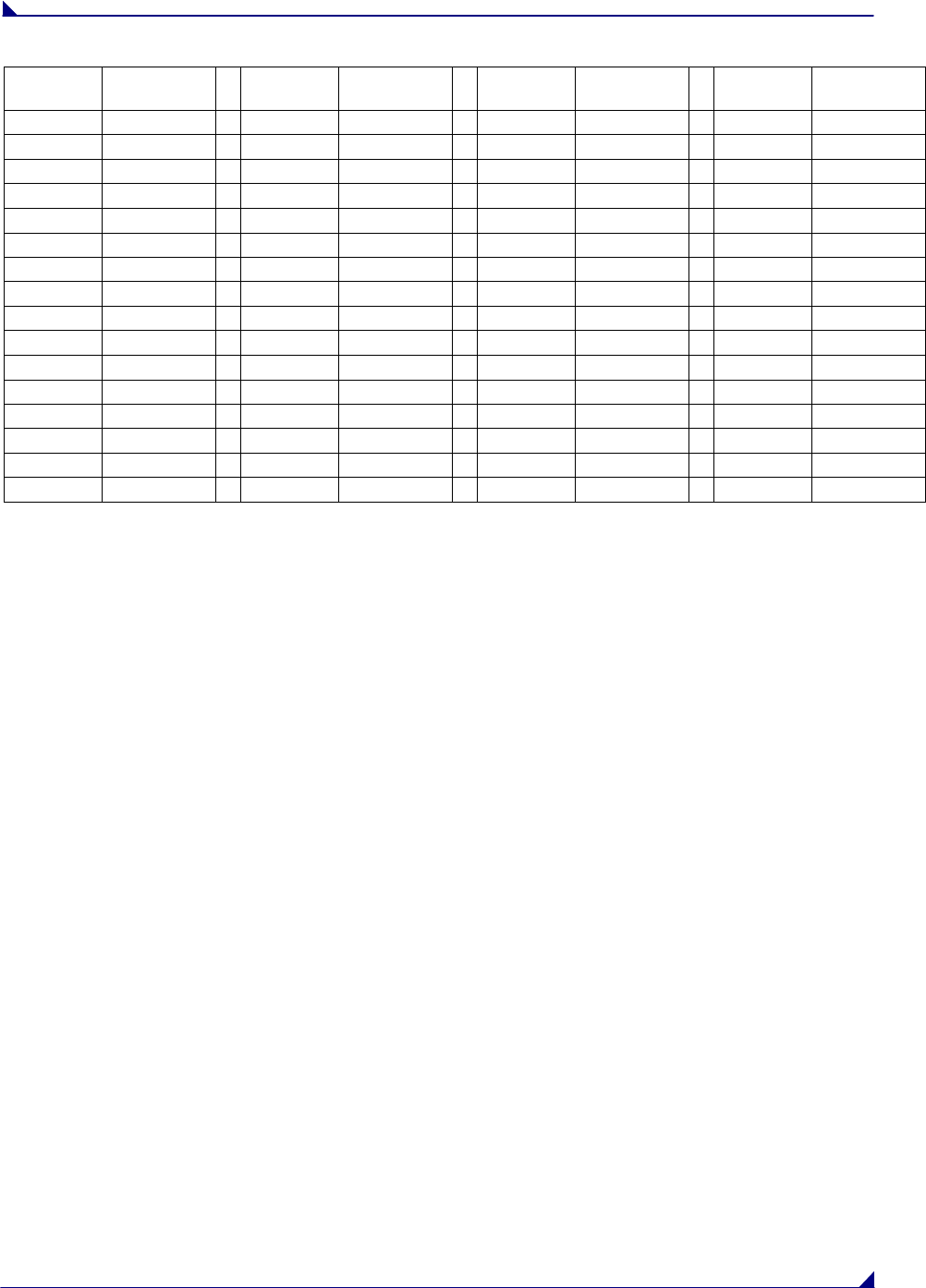
LRS400S Data Transceiver Users Manual
LUM0025AA Rev A Version 1.0 34
Channel
# Frequency
Channel
# Frequency
Channel
# Frequency
Channel
# Frequency
5800 426.2500 5960 427.2500 6120 428.2500 6280 429.2500
5810 426.3125 5970 427.3125 6130 428.3125 6290 429.3125
5820 426.3750 5980 427.3750 6140 428.3750 6300 429.3750
5830 426.4375 5990 427.4375 6150 428.4375 6310 429.4375
5840 426.5000 6000 427.5000 6160 428.5000 6320 429.5000
5850 426.5625 6010 427.5625 6170 428.5625 6330 429.5625
5860 426.6250 6020 427.6250 6180 428.6250 6340 429.6250
5870 426.6875 6030 427.6875 6190 428.6875 6350 429.6875
5880 426.7500 6040 427.7500 6200 428.7500 6360 429.7500
5890 426.8125 6050 427.8125 6210 428.8125 6370 429.8125
5900 426.8750 6060 427.8750 6220 428.8750 6380 429.8750
5910 426.9375 6070 427.9375 6230 428.9375 6390 429.9375
5920 427.0000 6080 428.0000 6240 429.0000 6400 430.0000
5930 427.0625 6090 428.0625 6250 429.0625
5940 427.1250 6100 428.1250 6260 429.1250
5950 427.1875 6110 428.1875 6270 429.1875